Josef Olmert”
post_date=”October 22, 2025 03:32″
pUrl=”https://www.fairobserver.com/world-news/middle-east-news/fo-talks-france-uk-canada-and-australia-recognize-palestine-what-does-it-mean-for-israel/” pid=”158746″
post-content=”
Editor-in-Chief Atul Singh and former Israeli Government Official Josef Olmert explore the diplomatic and political fallout after several Western powers formally recognized the State of Palestine. The two examine how this shift affects Israel’s global standing, its internal politics and broader regional alignments.
Recognition of Palestine
On Sunday, September 21, the United Kingdom, Canada and Australia recognized Palestine, followed by France the next day. Olmert calls this a symbolic yet consequential moment. In his view, the gesture has little immediate legal impact but carries deep political implications for Israel, marking what he calls “bad days for Israel.” He adds a touch of irony, noting that Britain’s supposed reward was an enormous demand for reparations from the Palestinian Authority.
Olmert sees the recognition as largely political signaling. He explains that the governments are responding to domestic pressure rather than to developments on the ground. Yet even symbolic acts can have real-world consequences when they alter perceptions and embolden political movements.
Is Israel’s popularity declining?
Olmert’s first major point concerns what he describes as a shift in public opinion against Israel across the West. He attributes it to changing demographics and new political coalitions, particularly in the UK. The Labour Party now appeals both to Muslim voters and to liberals who frame Palestine as an anti-colonial cause. Once firmly pro-Israel, the country’s major trade union federation has also reversed its stance.
These trends complicate relations between Israel and its traditional allies. Olmert recalls that under former Labour leader Jeremy Corbyn, Palestinian flags outnumbered British ones at party conventions, a symbolic sign of how opinion has turned. Large street demonstrations illustrate how the issue has become a moral rallying point for many voters.
He also predicts political backlash, suggesting that Britain’s right-wing Reform Party might gain ground in the next election. France is facing political paralysis reminiscent of its pre-war instability. The overall trend points to growing polarization: Sympathy for Palestinians is rising, while support for Israel among mainstream parties is eroding.
Israel’s military actions
The second major consequence, Olmert says, lies in the potential diplomatic and operational problems recognition may cause. He expects friction if Western nations try to open consulates for a new State of Palestine that requires access through Israeli territory. Israel, he warns, could respond by limiting cooperation or restricting diplomatic access.
Olmert explains Israel’s diplomatic prickliness within a much older Jewish experience of persecution. External pressure, he explains, tends to reinforce the sense of isolation that has historically defined Jewish identity. He recalls an old Hebrew expression that “the more you torture them, the stronger they get.” This idea, he says, reflects centuries of resilience shaped by exile and discrimination.
Outside criticism often strengthens Israel’s internal unity, especially during war. They agree that the charge of genocide leveled at Israel is false. Olmert emphasizes that Gaza’s population continues to grow and insists that wartime casualties, while tragic, do not constitute genocide. Drawing historical comparisons, he points out that civilian losses in past conflicts, such as the bombing of Tokyo in 1945, were far greater without being labeled as genocide.
Israel’s goals
Turning to domestic politics, Olmert is blunt about his disappointment in Israeli Prime Minister Benjamin Netanyahu. As Israel’s longest-serving leader, he says, he understood the country’s diplomatic challenges but failed to act on them. Olmert argues that Netanyahu should have rebuilt bipartisan goodwill abroad and moderated his government but instead allowed extremists like Minister of National Security Itamar Ben-Gvir and Minister of Finance Bezalel Smotrich to dominate the political narrative.
Olmert attributes Israel’s loss of international support to three converging trends: demographic change in Western cities, the ideological evolution of Europe’s social democracies and a new alliance of progressives, leftists and Islamists united by hostility toward the West.
On strategy, both speakers agree that Hamas, the Sunni Islamist Palestinian nationalist political group, remains Israel’s chief obstacle to peace. Destroying its military infrastructure, Olmert says, is essential to prevent another crisis on par with the October 7 attacks. Yet he also urges restraint: For Israel’s own long-term interest, the war should end as soon as possible. He proposes that Israel declare a short ceasefire to allow the unconditional release of hostages, resuming military operations only if that demand is ignored. Olmert believes peace requires neutralizing those who violently oppose it.
Saudi–Pakistani defense pact
Singh and Olmert also examine regional geopolitics. The Abraham Accords, once a centerpiece of Israeli diplomacy, have stalled, while new alliances are emerging, such as the recently announced Saudi–Pakistan defense pact. Olmert interprets it as a diplomatic signal from Saudi Crown Prince Mohammed bin Salman to US President Donald Trump, conveying that the Saudi capital of Riyadh “may have other options.” He argues that the agreement is not directed against Israel but could, paradoxically, strengthen ties between Israel and India as both countries coordinate more closely on security.
Despite Israel’s current diplomatic challenges, Olmert remains cautiously hopeful. Netanyahu still holds valuable leverage and could yet restore Israel’s standing if he acts decisively. Israel’s immediate challenge is to balance its security imperatives with the need to rebuild trust abroad. Ultimately, the recognition of Palestine by the two former European imperial powers and the two former Anglo-Saxon colonies is not the end of the story but the beginning of a new, unpredictable phase in the Middle East’s evolving power dynamics.
[Lee Thompson-Kolar edited this piece.]
The views expressed in this article/video are the author’s own and do not necessarily reflect Fair Observer’s editorial policy.
”
post-content-short=”
Editor-in-Chief Atul Singh and former Israeli Government Official Josef Olmert explore the diplomatic and political fallout after several Western powers formally recognized the State of Palestine. The two examine how this shift affects Israel’s global standing, its internal politics and broader…”
post_summery=”In this episode of FO° Talks, Atul Singh and Josef Olmert discuss how the coordinated recognition of Palestine by Western nations signals shifting global politics. Israel’s growing isolation stems from Western demographic and ideological changes and its own leadership decisions. Despite challenges, Singh and Olmert see potential for renewed diplomacy amid emerging alliances like the Saudi–Pakistan defense pact.”
post-date=”Oct 22, 2025″
post-title=”FO° Talks: France, UK, Canada and Australia Recognize Palestine, What Does It Mean for Israel?” slug-data=”fo-talks-france-uk-canada-and-australia-recognize-palestine-what-does-it-mean-for-israel”>
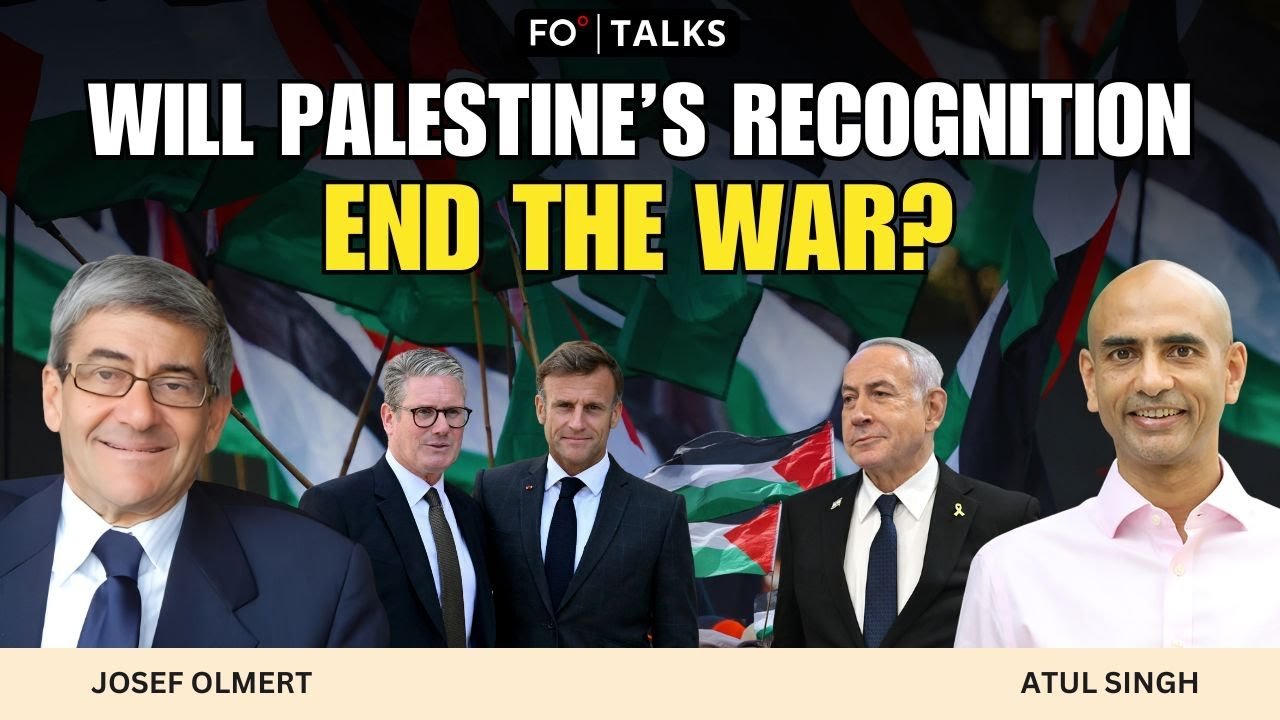
FO° Talks: France, UK, Canada and Australia Recognize Palestine, What Does It Mean for Israel?
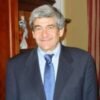
Saya Kiba”
post_date=”October 21, 2025 05:35″
pUrl=”https://www.fairobserver.com/politics/fo-talks-who-will-be-japans-next-prime-minister/” pid=”158734″
post-content=”
[This video was recorded before Sanae Takaichi was chosen as the president of the Liberal Democratic Party on October 4, 2025. It has been updated to include this information.]
Rohan Khattar Singh, Fair Observer’s Video Producer & Social Media Manager, speaks with Saya Kiba, an associate professor at Japan’s Kobe City University of Foreign Studies, regarding the resignation of former Prime Minister Shigeru Ishiba. They explore why Ishiba stepped down, the Liberal Democratic Party’s (LDP) leadership race, the top contenders and the challenges awaiting Japan’s next leader, from economic strain to a rising wave of right-wing populism.
Why did Ishiba resign?
As Kiba explains, Ishiba resigned on September 7, 2025, after the LDP suffered a string of electoral defeats. Under his leadership, the party lost three major elections: the lower house election shortly after he took office, the Tokyo Metropolitan Assembly election in June and the upper house election in July. These losses shattered the party’s dominance and triggered anxiety among LDP lawmakers who feared for their own seats.
Ishiba’s downfall was less about public opinion than internal revolt. Many within the LDP concluded he could not lead them to victory again. Lawmakers, worried about losing their constituencies, decided they needed a change in leadership before the next general election. His departure thus reflected a survival instinct within the party more than a change in national sentiment.
What’s next for Japan?
Japan will choose its next prime minister through an internal LDP leadership contest. The contest was held on October 4. In this contest, party members and parliamentarians shared the vote equally. The winner must be confirmed by the Diet to become prime minister. As Kiba explains, this parliamentary step is largely ceremonial — a “confirmation” rather than an election.
Once the LDP selects its new leader, the transition of power will be swift, with the new prime minister expected to take office quickly. But beyond the formalities, Khattar Singh and Kiba agree that this vote is highly impactful to Japan’s direction on both domestic and foreign policy, particularly given the split between the party’s liberal and ultra-conservative wings.
Top contenders and a winner
Kiba outlines five candidates for the LDP leadership but emphasizes three frontrunners.
The first is Sanae Takaichi, the only female contender. At 64 years old, she is known for her staunch conservatism and her close alliance with the late Prime Minister Shinzo Abe. Takaichi has opposed same-sex marriage and progressive gender policies, and she has made controversial remarks about historical events. Her campaign slogan, “Japan is Back,” echoes the populist tone of US President Donald Trump’s rhetoric.
The second major contender was Shinjiro Koizumi, aged 44, son of former Prime Minister Junichiro Koizumi. Currently serving as the agriculture minister, he built his platform around addressing inflation and rejuvenating Japan’s economy.
The third was Yoshimasa Hayashi, a 64-year-old diplomat who served as Ishiba’s chief of staff and government spokesperson. Kiba describes him as a pragmatic candidate with strong foreign policy credentials and close ties to former Prime Minister Fumio Kishida.
Ultimately, Takaichi won the LDP’s choice for president. She is currently on track to become Japan’s first female prime minister.
Who is Takaichi?
Takaichi’s rise captures the emotional pulse of Japan’s conservative base. As Kiba notes, many within the LDP miss Abe, whose strong leadership style still resonates. Takaichi represents a return to that era, promising discipline and national pride.
Her conservatism, however, divides the party. Critics within the LDP recall the Abe-era scandals over campaign financing and misuse of funds that eroded public trust. Yet these same controversies have ironically boosted Takaichi’s appeal among ultra-right voters who feel alienated by the more centrist Kishida and Ishiba factions.
This political shift has been reinforced by the rise of Sanseitō, a new far-right party that performed strongly in July’s upper house elections. Many of its supporters were once loyal to the LDP but defected over dissatisfaction with moderate policies. Khattar Singh and Kiba see this as a warning sign that the Japanese right is fracturing, and whoever succeeds Ishiba will need to mend these internal divisions.
Japan’s economy
Japan’s economy remains a central challenge for any incoming prime minister. Ishiba’s administration came under fire for a July 23 trade deal with the United States that many believed leaned in the US’s favor. The agreement left unresolved issues over tariffs on semiconductors and medical supplies, sparking criticism across party lines.
Kiba argues that the next leader must repair Japan’s trade posture and manage relations with the US, particularly as protectionist policies resurface in Washington. Inflation, still a pressing concern, is likely to dominate domestic debate. Khattar Singh adds that Japan’s recovery depends on restoring confidence in both fiscal policy and the leadership steering it.
Japan’s top issues
Beyond the economy, Khattar Singh and Kiba identify three major policy fronts:
- Trade and security: Japan must balance its tariff disputes with maintaining a strong US–Japan security alliance. Washington continues to pressure Tokyo to contribute more to defense costs — a politically sensitive issue amid voter fatigue.
- Inflation and domestic stability: The cost-of-living crisis has eroded public patience, and the new prime minister will need quick wins to restore confidence.
- Diplomacy and regional relations: Japan faces an increasingly tense neighborhood. On September 3, Chinese President Xi Jinping, Russian President Vladimir Putin and North Korean dictator Kim Jong Un met in Beijing, signaling a new phase of coordination among Japan’s nuclear-armed rivals. Managing this trilateral threat while maintaining close cooperation with the US and South Korea will be an early and defining test of Japan’s next leader.
The leadership race is about far more than replacing Ishiba. It is about the soul of Japan’s ruling party — whether it will return to Abe’s hardline nationalism or chart a new, pragmatic path through turbulent economic and geopolitical waters.
[Lee Thompson-Kolar edited this piece.]
The views expressed in this article/video are the author’s own and do not necessarily reflect Fair Observer’s editorial policy.
”
post-content-short=”
Rohan Khattar Singh, Fair Observer’s Video Producer & Social Media Manager, speaks with Saya Kiba, an associate…”
post_summery=”In this episode of FO° Talks, Rohan Khattar Singh and Saya Kiba discuss the vote to replace Japanese Prime Minister Shigeru Ishiba. Japan now confronts economic stagnation and a growing ultra-right movement demanding strong conservative leadership. The next prime minister — perhaps Liberal Democratic Party President Sanae Takaichi — must tackle inflation, US trade tensions and regional security challenges.”
post-date=”Oct 21, 2025″
post-title=”FO° Talks: Who Will Be Japan’s Next Prime Minister?” slug-data=”fo-talks-who-will-be-japans-next-prime-minister”>
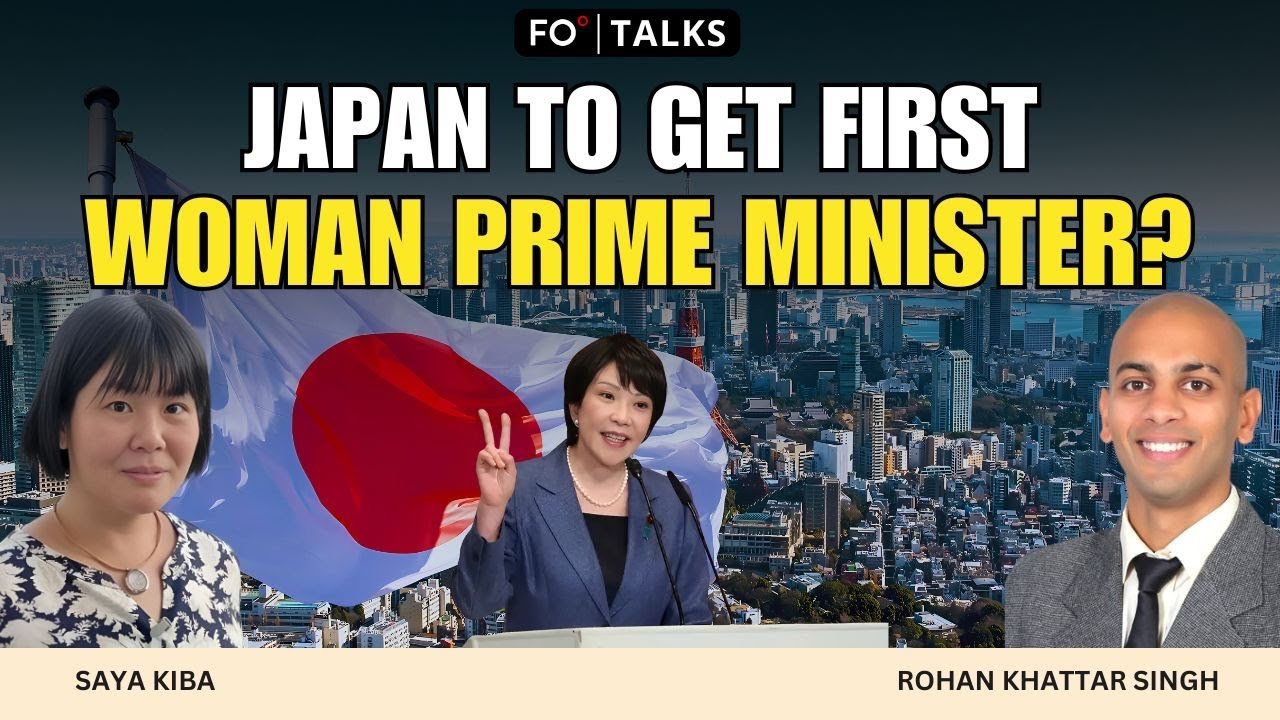
FO° Talks: Who Will Be Japan’s Next Prime Minister?

Douglas Hauer”
post_date=”October 20, 2025 07:12″
pUrl=”https://www.fairobserver.com/world-news/fo-talks-will-south-korean-companies-reconsider-business-in-america-after-the-hyundai-ice-raid/” pid=”158716″
post-content=”
Fair Observer’s Video Producer Rohan Khattar Singh speaks with Douglas Hauer, a former partner at Mintz and a lawyer with nearly three decades of experience, about the sudden Immigration and Customs Enforcement (ICE) raid at the Hyundai Motor Company’s Georgia plant. Hauer calls the event a watershed moment for US immigration enforcement. In his view, it marked a shift from deliberate coordination with corporate actors toward abrupt and highly visible action.
The raid, he explains, shows that US President Donald Trump’s administration “will not necessarily plan around trying to understand business considerations of a company […] before just launching into an enforcement action.” Such operations traditionally follow extensive fact-finding to avoid errors affecting large, publicly traded companies. The Hyundai case, however, seemed to unfold with limited caution and unclear justification. As Hauer understands it, the trigger may have been irregularities in employment documentation.
What disturbed him most was the excessive use of restraint. Individuals were handcuffed despite no evidence that they posed physical threats. The optics of the raid — images of workers detained in cuffs — left Hauer questioning whether officials had properly assessed the risks. He characterizes the operation as an overreaction and a failure of deliberation that disregarded economic and human stakes.
South Korea launches a probe
The raid quickly took on international dimensions. Facing public outrage, the South Korean government launched an investigation into possible human rights violations against its citizens employed at the Hyundai facility. Khattar Singh notes that this move placed Washington in an uncomfortable diplomatic position.
Hauer believes the probe is likely an internal initiative by the South Korean capital of Seoul to reassure its domestic audience rather than an accusation aimed squarely at the United States. Though he does not want to overstate it as a major diplomatic rupture, he acknowledges that it forced US officials to act defensively. Reports indicated that the State Department and the Department of Homeland Security began coordinating to ensure that the immigration records of deported workers were cleared so they could return.
For both Hauer and Khattar Singh, this episode illustrates how labor enforcement in one state can spiral into a foreign policy headache. The US, long seen as a reliable investment destination, suddenly appeared unpredictable — particularly when global companies employ a transnational workforce with complex visa histories.
More raids coming?
The broader question, Khattar Singh asks, is whether the Hyundai operation signals more such actions ahead. Hauer is skeptical. He predicts that this situation won’t recur, reasoning that the government will likely exercise greater caution after the backlash. While acknowledging the administration’s willingness to take aggressive action, he does not foresee a pattern of raids targeting high-profile corporations.
Still, he cautions that the damage is not purely reputational. Foreign investors should take away lessons in proactive engagement. A company investing millions in US facilities must build early relationships with government stakeholders. Had Hyundai worked with the US Embassy in Seoul to establish streamlined visa pathways, the crisis could have been averted.
Hauer sees the incident as a failure of relationship management rather than evidence of hostility to foreign business. He describes the administration as simultaneously “friendly” to investment and “negligent” in enforcement. That duality of welcoming capital while mishandling compliance creates uncertainty. His advice to corporations is to be sharp, not scared: Hire experienced advisers, anticipate scrutiny and document the economic value they bring.
What should immigrants do?
The conversation concludes with practical guidance for immigrants. Hauer stresses that individuals on visas cannot assume stability in the current environment. He advises them to check in with their immigration attorneys every few months, likening it to a routine dental appointment. Rules can shift rapidly, and the US Department of State’s Foreign Affairs Manual, once a reliable guide for consular officials, has been largely eliminated.
For workers with pending applications or prior infractions, he warns that leniency is no longer guaranteed. Even minor lapses can now trigger severe consequences. Khattar Singh presses him on whether the raid reflects a political effort to energize anti-immigrant sentiment. Hauer rejects that interpretation outright. He maintains that the event was “one additional misstep” rather than a calculated message to the president’s political base.
Yet he acknowledges a deeper cultural problem: Anti-immigrant sentiment remains the “connective tissue” that binds extremes on both the right and left. It surfaces during moments of social tension and feeds on economic fear. The Hyundai raid, viewed in that light, is less a singular scandal than a symptom of a nation still struggling to balance enforcement, compassion and global credibility.
Hauer closes by recommending immigrants to stay informed, maintain clean records and seek professional advice early rather than wait for crises. Businesses, meanwhile, must understand that the US remains open for investment — but no longer offers the predictability it once promised.
[Lee Thompson-Kolar edited this piece.]
The views expressed in this article/video are the author’s own and do not necessarily reflect Fair Observer’s editorial policy.
”
post-content-short=”
Fair Observer’s Video Producer Rohan Khattar Singh speaks with Douglas Hauer, a former partner at Mintz and a lawyer with nearly three decades of experience, about the sudden Immigration and Customs Enforcement (ICE) raid at the Hyundai Motor Company’s Georgia plant. Hauer calls the event a…”
post_summery=”In this episode of FO° Talks, Rohan Khattar Singh and Douglas discuss the recent ICE raid at Hyundai’s Georgia plant, which signals a reckless enforcement shift with diplomatic fallout. South Korea’s probe and the US backpedaling expose the raid’s global repercussions. Immigrants should stay legally vigilant and companies should engage the government early to prevent similar crises.”
post-date=”Oct 20, 2025″
post-title=”FO° Talks: Will South Korean Companies Reconsider Business in America After the Hyundai ICE Raid?” slug-data=”fo-talks-will-south-korean-companies-reconsider-business-in-america-after-the-hyundai-ice-raid”>
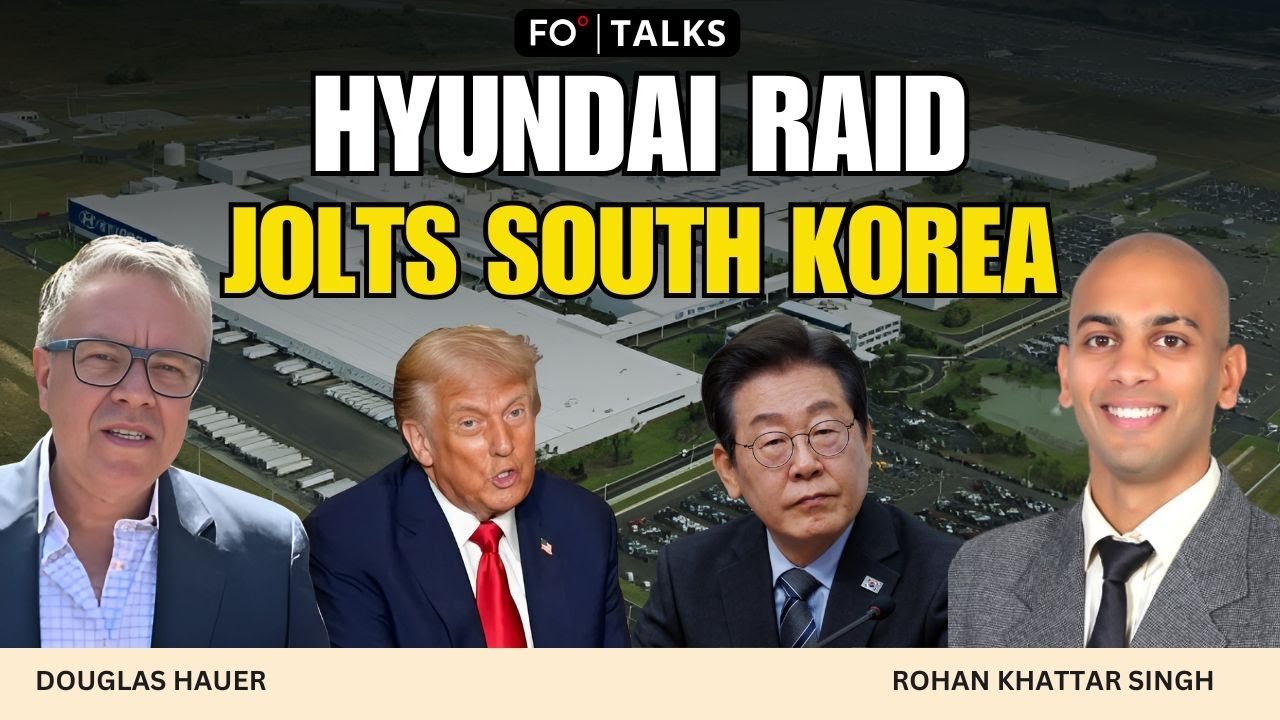
FO° Talks: Will South Korean Companies Reconsider Business in America After the Hyundai ICE Raid?

Douglas Hauer”
post_date=”October 19, 2025 06:09″
pUrl=”https://www.fairobserver.com/world-news/fo-talks-what-does-trumps-h-1b-visa-fine-mean-for-us-india-relations/” pid=”158698″
post-content=”
Fair Observer’s Video Producer Rohan Khattar Singh speaks with Douglas Hauer, a former partner at Mintz and a lawyer with nearly three decades of experience, about the US President Donald Trump’s surprise announcement imposing a $100,000 annual fee on new H-1B visa applications. The discussion examines the legal foundation of the measure, its market effects, and what it reveals about the direction of US immigration policy.
Legal ambiguity and administrative turmoil
Hauer begins by clarifying that the new rule, announced September 19, is not automatically enforceable. Its legality depends on whether courts allow implementation, since the administration bypassed standard rule-making procedures requiring public notice and comment. If blocked, it could be frozen before taking effect.
Should it proceed, employers will need to prove each foreign hire serves the “national interest of the United States.” Hauer predicts this evidentiary burden will shrink H-1B hiring, particularly in technology. The outcome, he explains, will be a trickle-down effect hurting international graduates on F-1 student visas who normally transition to H-1B roles after science, technology, engineering and mathematics training. Many may instead seek employment in Canada, the European Union or elsewhere.
Initial confusion worsened matters. The announcement first seemed to cover all H-1B holders before the White House clarified it applied only to new applicants. Hauer calls this political backpedaling, typical of an administration that releases sweeping ideas and then retreats once consequences become clear.
Hauer recalls a client who waited eight hours for an L-1 visa to be processed at a Canadian airport checkpoint, a procedure that usually takes only 15 minutes. This underscores the immediate administrative chaos the rule created.
Costs, ethics and corporate pressure
Khattar Singh next raises the key question: Who pays the $100,000 fee? Hauer confirms employers bear the cost but issues an ethical warning: Any firm asking employees to help cover the fee behaves unethically. Forcing repayment through unpaid labor, he argues, risks creating “a type of indentured servitude.” He cautions that some employers might expect workers to spend nearly half a year repaying these costs, an arrangement he says would violate both the spirit and ethics of US labor law.
Lobbying by large corporations led to a partial rollback. Tech and finance giants — Amazon, Microsoft, JPMorgan Chase and others — can afford selective sponsorships and were extremely influential in getting the administration to “walk this back.” Smaller firms, however, may lose global competitiveness under the new cost burden.
Disproportionate impact and the role of race
Khattar Singh cites a statistic that roughly 70% of all H-1B visas go to Indian nationals, many in IT and engineering. That concentration, Hauer argues, makes the rule racially and geographically discriminatory. Drawing a parallel to the Chinese Exclusion Acts of the 1880s, he contends racial bias has long shaped US immigration law and continues today.
“I think […] race figures into their policies on immigration all the time,” Hauer says. He asserts that the $100,000 fee is “absolutely meant to block many people from coming to the United States who are from India.” Such exclusion, he adds, is both racist and self-defeating. The US, he notes, has long benefited from Indian technical expertise — without which Apple, Microsoft and Amazon might not thrive.
A deteriorating climate for immigrants
Hauer warns that the US has become “unfriendly to immigrants more so than ever, probably since the 1880s.” He advises F-1 visa holders to reflect before committing to long-term US careers. The atmosphere of hostility, he predicts, will not vanish quickly, even once the administration changes. He speculates that a future administration could be even more ruthless, faulting both parties for decades of inaction.
Democrats, he says, have sat idly by for over 20 years, failing to modernize immigration in that time. Meanwhile, corporations that can afford lobbyists may tolerate the fee rather than fight it, leaving smaller employers and international talent exposed.
Exemptions and the road ahead
Hauer concludes with a note of conditional optimism. If courts do not overturn the rule, he expects national interest exemptions — likely for artificial intelligence, medical technology, healthcare institutions, satellites and semiconductor production. These carve-outs could be “fairly broadly construed,” tempering the worst effects but leaving the broader message intact: the door to US immigration is narrowing.
For Khattar Singh, the conversation underscores a larger trend: how economic nationalism is reshaping immigration into a privilege reserved for strategic industries, rather than a shared engine of growth. Whether courts block the policy or not, Hauer sees it as a test case in the ongoing struggle between political symbolism and the rule of law.
[Lee Thompson-Kolar edited this piece.]
The views expressed in this article/video are the author’s own and do not necessarily reflect Fair Observer’s editorial policy.
”
post-content-short=”
Fair Observer’s Video Producer Rohan Khattar Singh speaks with Douglas Hauer, a former partner at Mintz and a lawyer with nearly three decades of experience, about the US President Donald Trump’s surprise announcement imposing a $100,000 annual fee on new H-1B visa applications. The discussion…”
post_summery=”In this episode of FO° Talks, Rohan Khattar Singh and Doug Hauer discuss US President Donald Trump’s controversial decision to impose a $100,000 annual fee on new H-1B visas. Hauer warns that the policy, though legally uncertain, will shrink skilled immigration, especially from India. He predicts partial exemptions for strategic industries but a lasting chill toward immigrants.”
post-date=”Oct 19, 2025″
post-title=”FO° Talks: What Does Trump’s H-1B Visa Fine Mean for US–India Relations?” slug-data=”fo-talks-what-does-trumps-h-1b-visa-fine-mean-for-us-india-relations”>
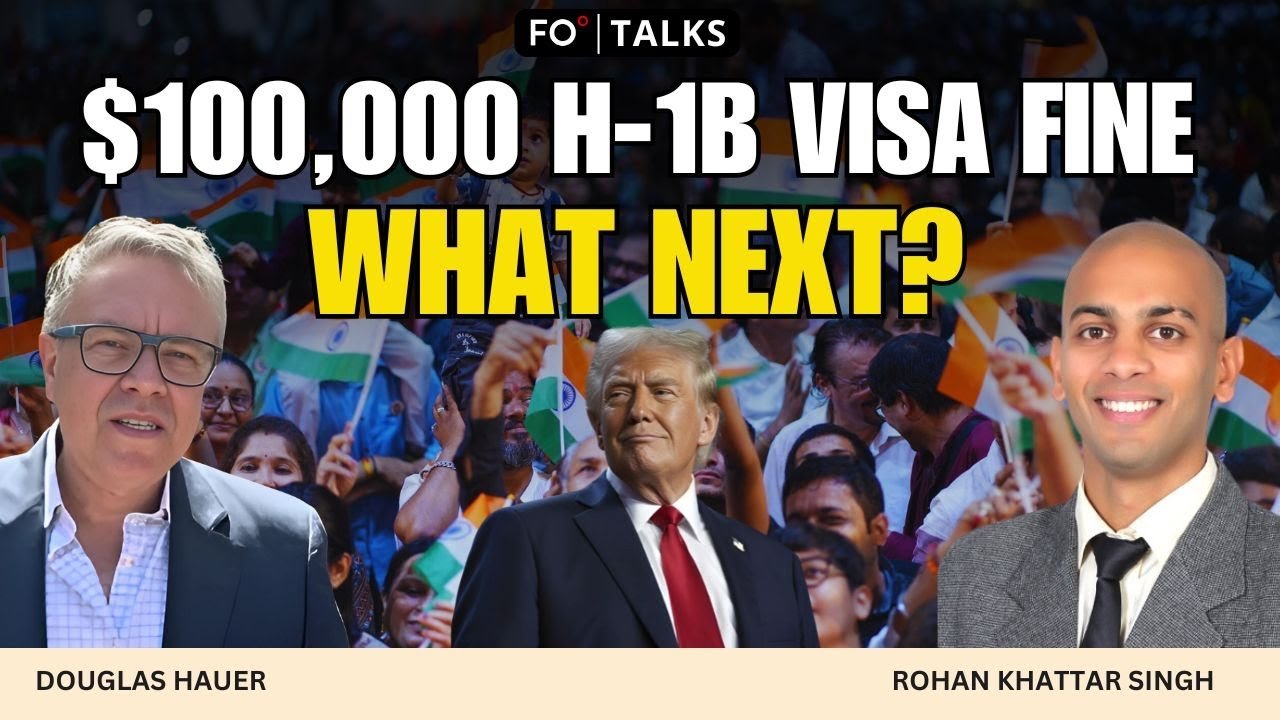
FO° Talks: What Does Trump’s H-1B Visa Fine Mean for US–India Relations?

Ilia Shumanov”
post_date=”October 18, 2025 04:02″
pUrl=”https://www.fairobserver.com/business/fo-talks-russian-diamonds-flood-europe-and-america-despite-sanctions-heres-how/” pid=”158679″
post-content=”
Fair Observer’s Video Producer Rohan Khattar Singh speaks with Director of Arctida Ilia Shumanov about how Russian diamonds continue entering Western markets despite sanctions. Shumanov, who has long reported on corruption, explains that the diamond trade offers a textbook case of legal evasion. Russia, the world’s largest source of rough diamonds, officially faces bans from the US, the UK and the EU. Yet its stones still sparkle in luxury boutiques across those same markets. The secret lies in a laundering triangle involving Russia, its “friendly” partners and the G7.
Russian diamond smuggling
Shumanov outlines how the network works. Rough stones leave Russia for “friendly countries” such as the United Arab Emirates, India and Armenia. There, they are cut, polished and certified. Once re-exported to Western destinations, they carry new paperwork claiming non-Russian origin.
Sanctions imposed in 2022 banned direct imports from Alrosa, the state-linked mining giant, but not diamonds processed elsewhere. So diamond producers can pull a technical trick: Russian diamonds become legally Indian or Armenian on paper. According to Shumanov, this bureaucratic disguise ensures that the volume of Russian stones in G7 markets remains unchanged from pre-sanction years.
Who profits?
Khattar Singh asks who truly benefits from this business. Shumanov explains that Alrosa and, by extension, the Russian state are still the principal winners. Alrosa has preserved its cashflow almost intact, channeling billions into Moscow’s budget through parallel routes. The secondary profiteers, he adds, are the middlemen — Dubai’s traders, Indian cutting houses and new Armenian brokers who have turned paperwork and logistics into a business of their own. Western retailers, too, are implicated.
“They know,” Shumanov insists, that every third diamond mined globally originates in Russia. Luxury stores prefer to rely on documents showing an Indian or Armenian source, even though “there are no Armenian […] diamond mines at all.”
Armenia’s role
Armenia, Shumanov notes, is the most surprising node in the chain. Official data show its diamond exports exceeded half a billion dollars in 2023, even though 96% of its imports came from Russia. The country has become the “ultimate loophole,” a jurisdiction untouched by US or EU sanctions where Russian stones can be legally processed and recertified. Once stamped with Armenian paperwork, they often move to Dubai and then into European and American markets.
Russian media have linked this flow to a Financial Stability Board-exposed embezzlement scheme involving Alrosa stones and Armenian companies, suggesting political complicity. For Shumanov, Armenia functions as a legal interface designed for “laundering the status and origin” of Russian gems.
How Alrosa evades sanctions
When Khattar Singh asks about Alrosa’s apparent resilience, Shumanov states that the company has multiplied proxies. After Alrosa was sanctioned, new firms, such as the Far Eastern Diamond Center, Trading Horizont and the First Brilliant Company, suddenly appeared. Their executives are former Alrosa employees. These fronts now handle shipments greater than Alrosa’s official exports. None are named on Western sanctions lists, making enforcement nearly impossible.
Shumanov calls them “classic cutouts,” noting that the West’s fixation on a single corporate name allowed Russia to rebrand its diamond trade overnight.
Blockchain tracks Russian diamonds
Khattar Singh turns to the technology fix. The G7 and Belgium have championed blockchain tracing systems that could follow a diamond’s origin from mine to boutique. Shumanov calls this innovation a “silver bullet” in theory, but “not actually implemented” in reality. The system covers only rough stones above one carat and remains voluntary.
Worse, the US Treasury’s Office of Foreign Assets Control granted a license in 2024 allowing global trade in Russian diamonds sold before March of that year. This, Shumanov says, opened a gaping loophole: Sellers can simply claim their stock predates the cutoff. Blockchain verification collapses under such claims because there is no global enforcement body ensuring truthful reporting.
Russia finds loopholes in sanctions
This situation parallels Russian oil being rerouted through India before returning to Western consumers as non-Russian refined fuel. Shumanov agrees that the diamond pattern mirrors that trade. “Friendly countries” like India, the UAE and Armenia, he says, have no incentive to enforce Western sanctions when they profit from the arbitrage. The West, meanwhile, prefers to maintain supply for its luxury markets. Political friction and limited regulatory capacity make it easier to look the other way. Russia, therefore, continues to fund its budget through diamonds.
Shumanov delivers a stark verdict: Western sanctions have failed. The stones may have new passports, but their glitter still finances Moscow’s war machine.
[Lee Thompson-Kolar edited this piece.]
The views expressed in this article/video are the author’s own and do not necessarily reflect Fair Observer’s editorial policy.
”
post-content-short=”
Fair Observer’s Video Producer Rohan Khattar Singh speaks with Director of Arctida Ilia Shumanov about how Russian diamonds continue entering Western markets despite sanctions. Shumanov, who has long reported on corruption, explains that the diamond trade offers a textbook case of legal evasion….”
post_summery=”In this episode of FO° Talks, Rohan Khattar Singh and Ilia Shumanov discuss how Russian diamonds continue entering Western markets despite sanctions. Russian stones are laundered through friendly countries like India, the United Arab Emirates and Armenia, exploiting legal loopholes. The operation exposes how global luxury markets still fund Russia’s economy under new labels.”
post-date=”Oct 18, 2025″
post-title=”FO° Talks: Russian Diamonds Flood Europe and America Despite Sanctions, Here’s How” slug-data=”fo-talks-russian-diamonds-flood-europe-and-america-despite-sanctions-heres-how”>
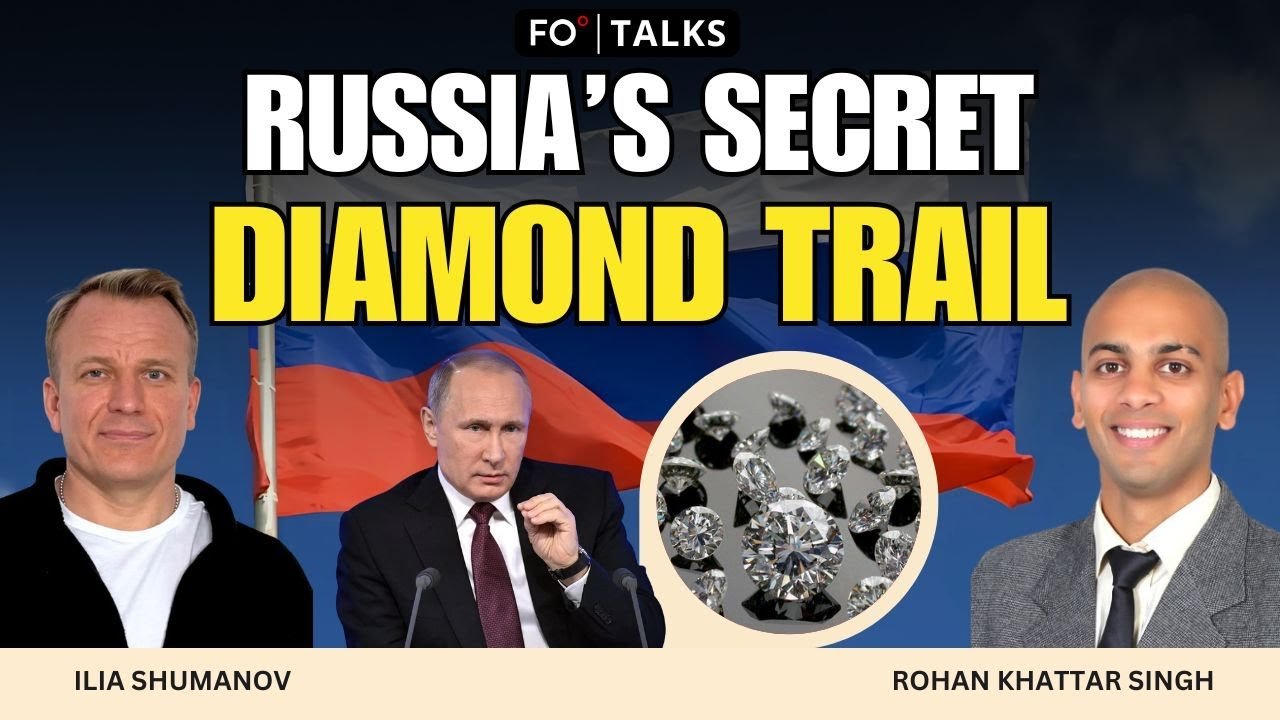
FO° Talks: Russian Diamonds Flood Europe and America Despite Sanctions, Here’s How

Agustina Vergara Cid”
post_date=”October 16, 2025 06:51″
pUrl=”https://www.fairobserver.com/politics/fo-talks-trump-administration-targets-legal-and-illegal-immigrants-with-ice-raids-heres-how/” pid=”158645″
post-content=”
Fair Observer’s Video Producer Rohan Khattar Singh speaks with Agustina Vergara Cid, an immigration law expert and Young Voices contributor, about her journey from Argentina to the United States and the state of US immigration under US President Donald Trump. Cid recently became a US citizen after a long, complex process that inspired her article for The Hill, titled “I just became an American citizen — don’t close the door behind me.” Becoming an American was not only a personal milestone for her, but also a call to defend the nation’s founding ideals, which she believes are at risk of being undermined by an unjust immigration system.
Cid’s legal journey to citizenship was difficult, expensive and emotionally draining. She arrived on a student visa and had to navigate a maze of legal categories, paperwork and fees. The process was so restrictive that it forced her to make painful sacrifices. Because those adjusting their immigration status cannot leave the country without risking their application, she was unable to visit her father in Argentina before he died. Thus, she views the immigration system as inhumane and detached from the values that America claims to uphold.
Immigration system
Cid describes the US immigration system as overly bureaucratic and structurally exclusionary. She argues that for most people who want to live and work in the country, there are simply not enough legal pathways. The law has evolved into what she calls an “anti-immigration system” — one that discourages and penalizes even those who attempt to comply with its requirements.
She frames the problem as a moral contradiction within American identity. Cid says she chose to become a citizen because she admired the principles of liberty and equality that define the nation’s founding story. Yet she finds that the system now betrays those ideals. She characterizes it as cruel, unfair and un-American, saying that it closes the door to others who wish to follow in her footsteps.
Discussing public attitudes, Cid remarks that the idea of America as a “land of immigrants” has been more myth than reality since the 1920s, when severe restrictions were first enacted. She attributes anti-immigrant sentiment partly to political fear-mongering, where leaders portray migrants as criminals to gain support for harsh enforcement.
However, she also believes that ordinary Americans are welcoming once they meet immigrants in person. She cites polling that shows record-high public support for immigration. This shift, she reasons, is a growing recognition that aggressive enforcement harms not only undocumented workers but also their law-abiding neighbors and coworkers.
Life for immigrants under Trump
Singh asks about the real-world effects of Trump-era policies on immigrant communities. Cid responds that the past decade has been defined by fear and uncertainty. She argues that the government’s focus on deportations, combined with military-style raids by Immigration and Customs Enforcement (ICE), created what she calls a “reign of terror” for both legal and undocumented immigrants.
According to her, the enforcement system under Trump blurred the line between legal and illegal status. Even those who followed every legal requirement — such as asylum seekers and green card holders — found themselves at risk of detention or revocation of status. She adds that some US citizens were mistakenly detained without access to lawyers or family, a violation of their constitutional rights.
Cid clarifies key legal distinctions: Entering the country without authorization is a criminal offense, while overstaying a visa is a civil violation. Yet she stresses that most undocumented immigrants are working people who contribute to society but lack a feasible legal route to do so. To her, the system punishes effort and compliance rather than rewarding them.
Trump 1.0 vs. Trump 2.0
Comparing the two Trump terms (2017–2020 versus now), Cid observes a major shift in focus. During Trump’s first presidency, the emphasis was on external barriers — the physical wall and restrictive regulations advocates call “Trump’s invisible wall.” The second term, she says, centers on internal enforcement: large-scale deportations and intensified removal operations.
She points out that former US President Barack Obama oversaw more deportations than Trump’s first administration, but the tone and tactics differ sharply. The current approach, she argues, prioritizes extracting people who are already integrated into American communities “by any means necessary,” often disregarding due process. While she agrees that violent offenders should be deported, she insists that most ICE targets are peaceful, law-abiding residents. Cid cites cases where asylum-seekers with pending claims were forcibly returned to dangerous conditions abroad, calling this a profound breach of both law and morality.
Advice to immigrants
Despite the turmoil, Cid ends on a note of cautious optimism. She urges immigrants to be meticulous about their applications, stressing that even minor errors can lead to rejection. Her strongest advice is to secure legal representation, since navigating the system without expert help has become nearly impossible.
Cid acknowledges that these are “very dark times” for immigrants, but she continues to see America as a beacon of freedom whose core values can endure. She expresses faith that the country will ultimately correct its course and live up to the promise that drew generations of newcomers to its shores. For her, the long road to citizenship serves as both a warning and a reminder: The ideals that make America worth joining must be defended by those who have fought hardest to be part of it.
[Lee Thompson-Kolar edited this piece.]
The views expressed in this article/video are the author’s own and do not necessarily reflect Fair Observer’s editorial policy.
”
post-content-short=”
Fair Observer’s Video Producer Rohan Khattar Singh speaks with Agustina Vergara Cid, an immigration law expert and Young Voices contributor, about her journey from Argentina to the United States and the state of US immigration under US President Donald Trump. Cid recently became a US citizen…”
post_summery=”In this episode of FO° Talks, Rohan Khattar Singh and Agustina Vergara Cid discuss her path to US citizenship and the challenges facing immigrants under America’s restrictive legal framework. Cid contrasts American ideals with an exclusionary, unjust system. She warns that US President Donald Trump’s deportation drive deepens fear but urges immigrants to persist and seek legal support.”
post-date=”Oct 16, 2025″
post-title=”FO° Talks: Trump Administration Targets Legal and Illegal Immigrants with ICE Raids, Here’s How” slug-data=”fo-talks-trump-administration-targets-legal-and-illegal-immigrants-with-ice-raids-heres-how”>
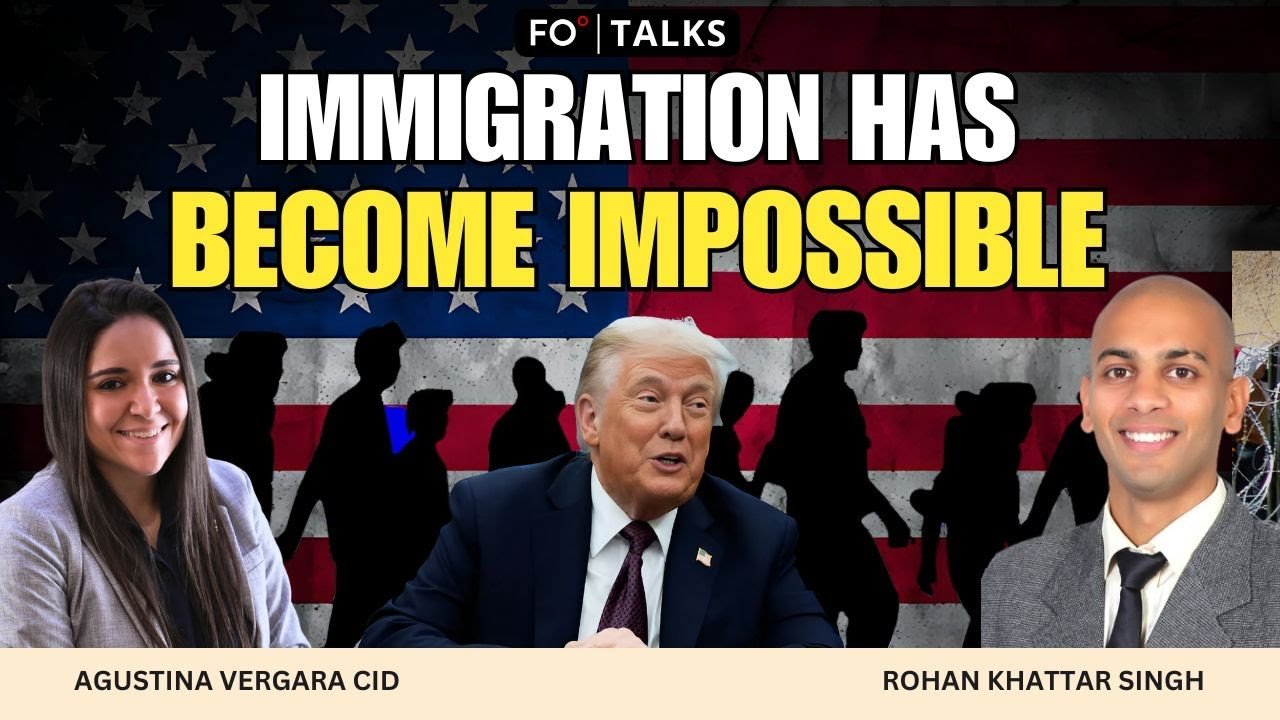
FO° Talks: Trump Administration Targets Legal and Illegal Immigrants with ICE Raids, Here’s How

Kyle Moran”
post_date=”October 15, 2025 07:16″
pUrl=”https://www.fairobserver.com/region/latin_america/fo-talks-venezuelas-maduro-rallies-his-supporters-as-tensions-with-us-escalate/” pid=”158649″
post-content=”
Fair Observer’s Video Producer Rohan Khattar Singh speaks with Kyle Moran, a political commentator and Young Voices contributor, about rising hostilities between the US and Venezuelan President Nicolás Maduro. The discussion explores US military strikes, oil and drug politics, regional instability and the risk that tensions could turn into open conflict.
US–Venezuela tensions
Singh notes “quite a bit of escalation” in recent weeks. US forces have carried out multiple strikes on Venezuelan boats allegedly carrying narcotics bound for the US, the latest (at time of recording) on September 15, 2025. The Pentagon has also moved aircraft and naval assets into the Caribbean, prompting speculation about preparations for war.
Moran characterizes the American strategy as one of “maximum pressure and minimum coherence.” While Washington tightens sanctions, it still allows Chevron Corporation to operate oil wells in Venezuela. The policy makes little sense because Petróleos de Venezuela, S.A., the state-owned giant, controls all exports and has even blocked shipments over unpaid fees. Since Chevron cannot pay in dollars, it compensates the regime in crude oil — effectively free oil for Maduro. Pursuing this policy while increasing military pressure, Moran argues, demonstrates the inconsistency at the heart of US strategy.
Trump wants war?
The US buildup includes Lockheed Martin F-35 Lightning II fighter jets in Puerto Rico and Navy destroyers near Venezuelan waters. Washington calls the attacks anti-narcotics operations, while Maduro claims they hit civilians. Moran believes a full invasion is unlikely, but intermediate military actions remain possible.
He argues that Maduro “has had a terrible track record” and accuses him of aiding drug networks like Cartellis de Solas and Tren Aragua. Moran agrees with US Secretary of State Marco Rubio’s condemnations, viewing the regime’s narco-terrorism links as a financial lifeline amid cash shortages. He predicts growing military escalation in the region.
Can Maduro respond?
Maduro claims to have mobilized eight million militia volunteers, but Moran says intelligence suggests the move is largely symbolic. He doubts Venezuela’s ability to counter modern US operations, arguing that its forces would struggle severely.
Moran sees the regime’s show of unity as political theater: Maduro must project national cohesion, yet the ground reality is very different. Once richer than many European countries, Venezuela now faces extreme poverty, food shortages and hyperinflation. Moran expresses sympathy for ordinary citizens and says the regime’s loss of legitimacy is “hard to overstate.”
Drugs or oil?
Venezuela holds the world’s largest oil reserves, but sanctions restrict sales mostly to China, India and Iran. The US has recently resumed small-scale purchases, a move Moran criticizes. When Singh asks whether this conflict is about oil or drugs, Moran replies that “the simple answer to that is it’s about the drugs.”
Moran labels the renewed oil purchases a “very bad misstep” akin to the era of US President Joe Biden, forced by high energy prices. The administration of US President Donald Trump both revoked and later restored oil licenses, undercutting its own maximum pressure campaign. Such policy swings, he says, expose Washington’s strategic incoherence.
China and Russia
Over ten million Venezuelans have fled abroad, destabilizing neighbors like Colombia. Moran highlights the territorial dispute over the Essequibo region with Guyana, calling Venezuela’s annexation threat an “existential threat to […] Guyana.” Guyana is firmly aligned with the US, while Brazilian President Lula da Silva performs a “delicate balancing act” — opposing war but sympathetic to Maduro.
Among global patrons, Moran believes China wields far greater influence than Russia. He rejects the claim that US drilling deters Chinese dominance, calling it “a fever dream” designed to justify Chevron’s presence. The oil output gains from this policy, he adds, are extremely unfortunate.
Will tensions spike?
Moran predicts further action against the Venezuelan capital of Caracas. He foresees strikes stronger than recent boat attacks but short of invasion. Moran insists Trump is “not a war hawk” yet “not an isolationist.” He will use force if he deems it in the national interest.
Given deployments, Moran does not see this conflict simply disappearing, though he stops short of predicting regime change. If US forces down Venezuelan aircraft, Maduro will face a dilemma: retaliate and risk collapse, or stand down and appear weak. “If he starts bombing or really messing around with US military personnel,” Moran warns, “this is going to end badly for him.”
Moran concludes that a decisive attack would end Maduro’s regime, but limited conflict now seems more likely than peace.
[Lee Thompson-Kolar edited this piece.]
The views expressed in this article/video are the author’s own and do not necessarily reflect Fair Observer’s editorial policy.
”
post-content-short=”
Fair Observer’s Video Producer Rohan Khattar Singh speaks with Kyle Moran, a political commentator and Young Voices contributor, about rising hostilities between the US and Venezuelan President Nicolás Maduro. The discussion explores US military strikes, oil and drug politics, regional…”
post_summery=”In this episode of FO° Talks, Rohan Khattar Singh and Kyle Moran examine escalating US-Venezuela tensions, sparked by American strikes on alleged drug-running vessels and a broader military buildup. Moran argues Washington’s approach mixes pressure with confusion — sanctioning Caracas while allowing the Chevron Corporation to drill for oil. He predicts further US action and warns that regional instability could intensify.”
post-date=”Oct 15, 2025″
post-title=”FO° Talks: Venezuela’s Maduro Rallies His Supporters as Tensions With US Escalate” slug-data=”fo-talks-venezuelas-maduro-rallies-his-supporters-as-tensions-with-us-escalate”>
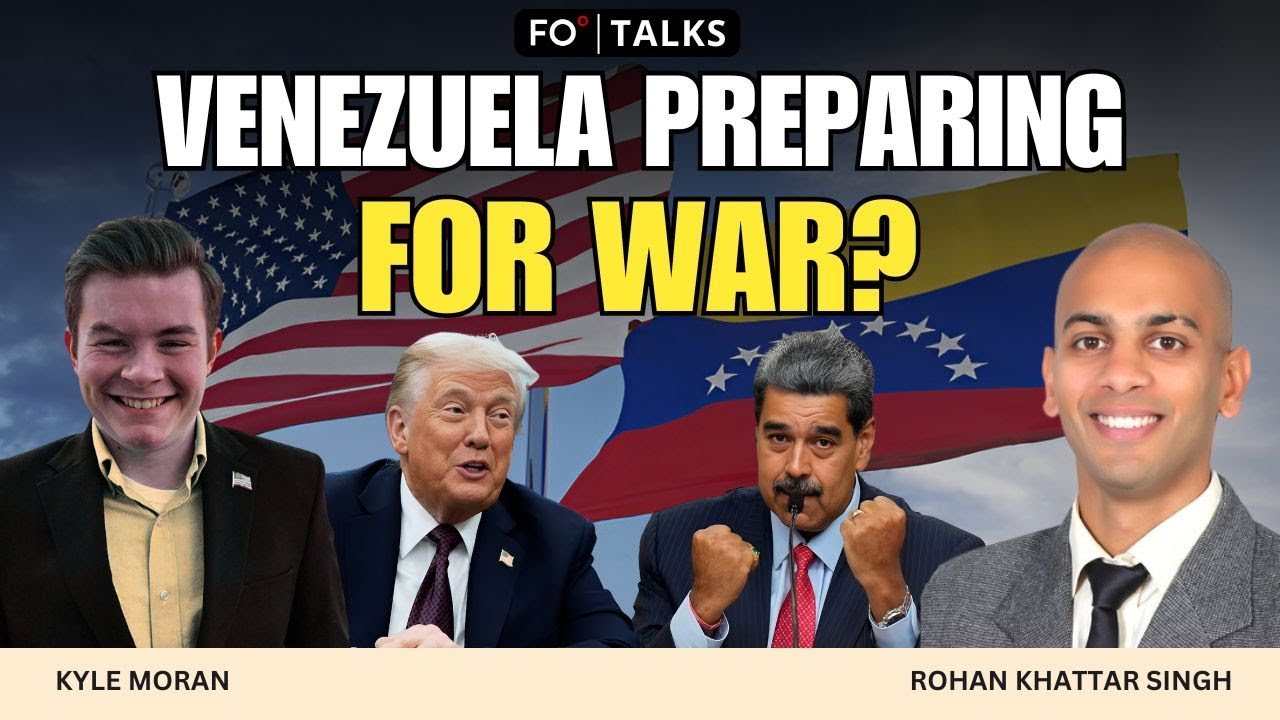
FO° Talks: Venezuela’s Maduro Rallies His Supporters as Tensions With US Escalate

Saya Kiba”
post_date=”October 14, 2025 06:34″
pUrl=”https://www.fairobserver.com/region/asia_pacific/fo-talks-japans-ties-with-philippines-soar-amid-china-tensions-will-india-join-the-alliance/” pid=”158622″
post-content=”
Rohan Khattar Singh, Fair Observer’s Video Producer & Social Media Manager, speaks with Saya Kiba, an associate professor at Japan’s Kobe City University of Foreign Studies, regarding the growing importance of the Philippines in Southeast Asia and its deepening partnership with Japan. Their conversation traces history, new security arrangements and the potential role of India in shaping regional dynamics.
Japan–Philippines relations
Khattar Singh notes that the Philippines is seen as Japan’s most trusted ally in Asia. Kiba recalls how former Japanese Prime Minister Fumio Kishida called the relationship a “golden age” two years ago, echoed by Filipino President Ferdinand Marcos Jr. during Japanese Prime Minister Shigeru Ishiba’s visit this year.
Post-World War II relations were strained. Reparations concluded by the 1970s, but anti-Japanese sentiment lingered. Over time, “people-to-people exchange” transformed perceptions. Japanese businesspeople gained a reputation for being sincere, unlike wartime memories. In the 1980s and 1990s, Filipino entertainers migrated to Japan, married and settled there, deepening social links.
This exchange expanded further after the 2008 Free Trade Agreement, when Filipino nurses and caregivers began working in Japan, aiding its aging society. Japanese youth also traveled to the Philippines for English education, as they admired Filipino teachers. Conversely, Filipinos valued Japan’s public order, safety and cleanliness, qualities seen as rare in the region. Khattar Singh calls this transformation a “brilliant case study” in how grassroots connections foster alliances beyond formal diplomacy.
Tensions with China
China’s assertive actions in the West Philippine Sea remain the “elephant in the seas.” Kiba describes rising tensions, and Khattar Singh notes Beijing’s bullying behavior toward the Philippine capital of Manila.
Japan and the Philippines share a commitment to freedom of navigation. Japan has bolstered the Philippines’ maritime capacity with advanced incoherent scatter radar systems. Though Tokyo’s rules forbid lethal weapons, these exports strengthen the Philippines’ monitoring and defense capacity.
Japan also supplies Coast Guard vessels through Official Development Assistance. Though framed as tools for law enforcement, they are deployed in contested waters like Scarborough Shoal in the South China Sea, often facing Chinese challenges. These moves show how Japan balances pacifist limits with real-world security needs and growing pressure from its regional environment.
Balikatan 2025
Cooperation accelerated with the 2024 Reciprocal Access Agreement, which eased joint operations between the Philippine military and Japan’s Self-Defense Forces. As a result, Japan joined the 2025 Balikatan exercise as a full participant.
Kiba calls this shift remarkable, given Balikatan’s historic focus on Philippine-US ties. Japan’s inclusion demonstrates Tokyo’s growing seriousness and signals that its role in regional security is changing. For Khattar Singh, it also illustrates how Japan’s cautious stance is giving way to more proactive engagement, driven by shared concerns over China and regional stability.
India–Japan–Philippines partnership
Khattar Singh and Kiba then turn their attention to India. Kiba highlights former Japanese Prime Minister Shinzo Abe’s lasting impact, which linked Japan’s strategy with India. India has supplied BrahMos supersonic cruise missiles to Manila, and President Marcos visited the Indian capital of New Delhi recently. These developments signal stronger defense ties.
A trilateral alliance of India, Japan and the Philippines is not formalized, but analysts are discussing it at the Track II level — when non-state actors converse to reduce tensions between conflicting groups. India, unlike Japan, does not face pacifist constraints on arms exports. It can provide maritime awareness systems and equipment more freely, making it an attractive partner for Manila. Khattar Singh and Kiba agree that a future framework could significantly boost Indo-Pacific security.
What do Filipinos feel?
Based on her personal experience, Kiba praises the Philippines’ vibrant political culture, with voter turnout exceeding 80%, far higher than Japan’s. She admires Filipinos’ civic engagement and commitment to free speech.
Filipinos increasingly see Japan as a top tourist destination and model of governance. Once viewed mainly as a source of jobs, Japan is now sought out for education and business opportunities. For many, Japanese institutions embody stability, order and reliability. Kiba concludes that Filipinos hold strong respect for Japan’s achievements and admire its ability to maintain social cohesion.
Future of Japan–Philippines ties
Kiba notes that the Philippines has a median age of 25 and believes Japan must refresh its view. Her generation saw the Philippines as a developing aid recipient, but today’s Japanese youth see it as modern and even a source of teachers.
Khattar Singh agrees Japan must adapt. The Philippines is emerging as a provider of regional public goods. For example, in 2021, the Japanese government issued disaster relief equipment to aid the Philippines during Typhoon Rai. Then, in February 2023, Philippine forces reused this equipment to aid Turkey, providing earthquake relief. Manila is also exploring South–South cooperation, supporting other developing nations and aspiring to donor status.
Kiba predicts such initiatives will grow. With shared democratic values, expanding defense ties and deep cultural links, Japan and the Philippines have positioned themselves not just as allies but as co-providers of stability in Southeast Asia and the broader Indo-Pacific.
[Lee Thompson-Kolar edited this piece.]
The views expressed in this article/video are the author’s own and do not necessarily reflect Fair Observer’s editorial policy.
”
post-content-short=”
Rohan Khattar Singh, Fair Observer’s Video Producer & Social Media Manager, speaks with Saya Kiba, an associate professor at Japan’s Kobe City University of Foreign Studies, regarding the growing importance of the Philippines in Southeast Asia and its deepening partnership with Japan….”
post_summery=”In this episode of FO° Talks, Rohan Khattar Singh and Saya Kiba explore how Japan and the Philippines have built trust through decades of cultural exchange and stand together in the face of rising regional tensions. They highlight joint security efforts and Japan’s growing role as a defense partner. They also consider India’s place in this evolving Indo-Pacific partnership.”
post-date=”Oct 14, 2025″
post-title=”FO° Talks: Japan’s Ties With Philippines Soar Amid China Tensions. Will India Join the Alliance?” slug-data=”fo-talks-japans-ties-with-philippines-soar-amid-china-tensions-will-india-join-the-alliance”>
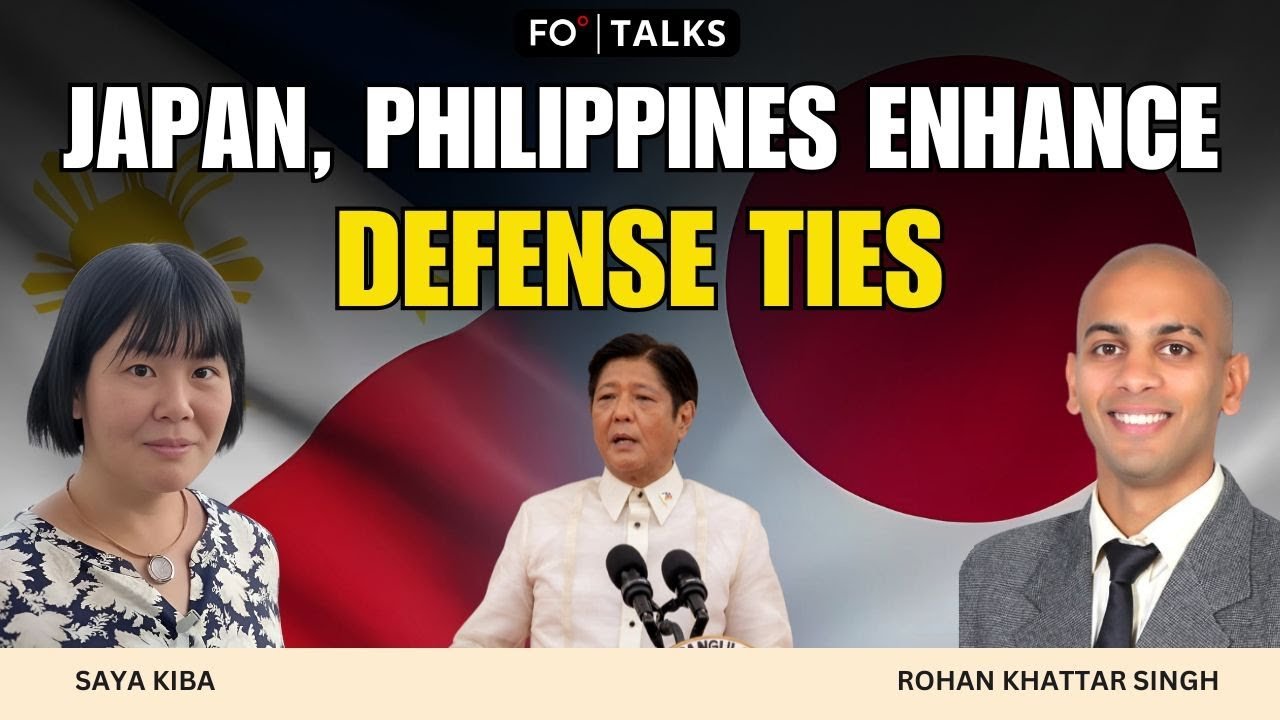
FO° Talks: Japan’s Ties With Philippines Soar Amid China Tensions. Will India Join the Alliance?

Sayuri Oyamada”
post_date=”October 13, 2025 06:13″
pUrl=”https://www.fairobserver.com/culture/fo-talks-after-sushi-ramen-and-matcha-actor-sayuri-oyamada-picks-the-next-viral-japanese-food/” pid=”158598″
post-content=”
Rohan Khattar Singh, Fair Observer’s Video Producer & Social Media Manager, speaks with Sayuri Oyamada, a Japanese actress, model and entrepreneur based in New York. Oyamada is the founder of Oyama Group and Oyama Onigiri, creative ventures through which she shares her passion for spreading Japanese culture and traditions. She explains that cooking Japanese meals became a healing ritual during the pandemic and that her work is rooted in sharing deeper values of Japanese food: simplicity, balance and care for both body and spirit.
Japanese cuisine
Oyamada explains that Japanese food is far more diverse than many outsiders assume. Too often, she says, people believe it consists only of sushi and ramen. In reality, Japan’s food culture is built around seasonal ingredients, simple home cooking and regional specialties. Onigiri, miso soup and vegetable dishes tied to the four seasons form the foundation of Japanese eating habits.
She also addresses the global perception that Japanese food is simply “healthy.” While health is part of it, Oyamada believes this is only one aspect. To her, Japanese cuisine is a holistic experience: picking vegetables in the mountains, sharing hot pot (a warm stew) with family and delighting in beautiful presentation. It is about flavor, artistry and togetherness just as much as physical wellbeing.
Onigiri in New York
Onigiri, a rice ball often filled with vegetables, fish or meat, is considered soul food in Japan. Oyamada recalls her childhood memories of eating her mother’s onigiri with miso soup, meals full of warmth and family care that shaped her values around food.
When she moved to New York, Oyamada was amazed to see a boom in onigiri’s popularity. In 2020, she could only find it in a few Japanese grocery stores. Today, almost everyone in the city has tried it at least once. She says this makes her proud and hopeful about the global reach of Japanese cuisine.
Part of onigiri’s appeal lies in its beauty. Oyamada points out how food aesthetics play a huge role in social media culture. She shares how she creates colorful onigiri by mixing rice with shiso leaves, which turn it purple, or by incorporating matcha for a vivid green whipped cream. She wants Japanese food to be both delicious and visually captivating, an edible art form that inspires worldwide admiration.
Japan’s next viral food
Looking ahead, Oyamada predicts that wagashi, traditional Japanese sweets, will be the next culinary export to capture global attention. Wagashi reflect Japan’s seasons and culture through delicate forms and subtle flavors. Paired with matcha, she says, they are unforgettable.
She also believes fermented foods like miso (soybean paste), kōji (a fermentation-starting fungus) and nattō (fermented soybeans) will continue rising in popularity. New Yorkers prize fermentation for both health benefits and umami — the fifth taste beyond sweet, salty, sour and bitter. Oyamada explains umami as a unique richness that makes food deeply satisfying. She uses kōji to marinate salmon, enhancing flavor in a way she finds transformative.
Hara hachi bu and ikigai
Khattar Singh turns the conversation to longevity. Japan has one of the world’s highest life expectancies, a fact often linked to diet and lifestyle. Oyamada emphasizes the practice of hara hachi bu, or eating until one is about 80% full. This cultural habit, she says, keeps people healthier and may contribute to long lives. She suggests this mindset could benefit people everywhere, not only in Japan.
Khattar notes the popularity of the international best-selling book, Ikigai: The Japanese Secret to a Long and Happy Life, which ties diet and lifestyle to the Japanese concept of ikigai — “a reason for being.” Oyamada agrees that mindful eating, restraint and a balanced relationship with food are central to Japanese wellbeing. For her, longevity is not just a result of food but of an entire culture of moderation and appreciation.
Indian cuisine
Comparing Japan and India, Oyamada reflects on her surprise at India’s wide range of spicy dishes. She especially enjoyed roti and observed that, while delicious, Indian food often felt heavy due to its frequent use of oil. Japanese food, in contrast, tends to avoid excess oil and sweetness, relying instead on fresh, seasonal vegetables.
Still, Oyamada sees common ground between the two cuisines. Apart from rice, yogurt is beloved in both cultures, forming part of daily diets and traditions. She expresses interest in learning more about Indian cooking in the future.
Try onigiri today
Oyamada closes with a simple invitation: Try onigiri. For her, it is Japan’s ultimate soul food, a humble rice ball that carries centuries of tradition, family warmth and cultural pride. Born in Niigata, a prefecture famous for its high-quality rice, Oyamada feels naturally called to share its deeper values with the world. Through onigiri, she believes people will not only be nourished, but taste the spirit of Japanese life.
[Lee Thompson-Kolar edited this piece.]
The views expressed in this article/video are the author’s own and do not necessarily reflect Fair Observer’s editorial policy.
”
post-content-short=”
Rohan Khattar Singh, Fair Observer’s Video Producer & Social Media Manager, speaks with Sayuri Oyamada, a Japanese actress, model and entrepreneur based in New York. Oyamada is the founder of Oyama Group and Oyama Onigiri, creative ventures through which she shares her passion for spreading…”
post_summery=”In this episode of FO° Talks, Rohan Khattar Singh and Sayuri Oyamada discuss Oyamada’s mission to share Japanese food culture worldwide. She highlights the soul food role of rice onigiri, culinary art and the rising popularity of wagashi sweets. She further reflects on the Japanese concepts of hara hachi bu (conservative eating) and ikigai (“a reason for being”).”
post-date=”Oct 13, 2025″
post-title=”FO° Talks: After Sushi, Ramen and Matcha, Actor Sayuri Oyamada Picks the Next Viral Japanese Food” slug-data=”fo-talks-after-sushi-ramen-and-matcha-actor-sayuri-oyamada-picks-the-next-viral-japanese-food”>

FO° Talks: After Sushi, Ramen and Matcha, Actor Sayuri Oyamada Picks the Next Viral Japanese Food

Kuber Chalise”
post_date=”October 12, 2025 05:57″
pUrl=”https://www.fairobserver.com/politics/fo-talks-nepals-prime-minister-oli-resigns-after-deadly-protests-what-next/” pid=”158588″
post-content=”
[This interview was recorded on September 9, 2025. Nepal’s Prime Minister KP Sharma Oli resigned during the recording.]
Rohan Khattar Singh, Fair Observer’s Video Producer & Social Media Manager, speaks with Kuber Chalise, a journalist for Nepal Khabar, regarding the protests and political crisis shaking Nepal. They examine the spark that ignited the movement, the mounting pressure on then-Prime Minister KP Sharma Oli and the broader questions of corruption, youth demands and geopolitics that define the country’s future.
What sparked the protests?
The immediate spark came when the government required social media platforms to register directly with the Ministry of Communication or face closure within a week. Although these companies were already paying taxes through local agents, they refused the order. The government shut down platforms, triggering outrage.
Chalise notes that the government’s intent seemed to be to control online criticism, where opposition voices and young citizens were active. The ban proved to be the last straw, unleashing long-held frustrations. Unlike Nepal’s earlier mass protests in 1990 and 2006, this one was led not by political parties, but by ordinary youths.
Underlying anger runs deeper. Young people feel excluded from opportunities, with jobs reserved for relatives of politicians. KP Sharma Oli is widely accused of corruption and of shielding business interests. Despite the shift from monarchy to republic two decades ago, many feel “nothing has changed.” Leaders are described as acting like kings, while their children flaunt luxury watches and designer brands.
Will KP Sharma Oli be arrested?
The protests turned violent as crowds marched toward parliament in Baneshwor, the largest residential area of Kathmandu, Nepal. Police opened fire, killing at least 20 protesters. Doctors noted that many were shot in the head or chest, not below the knee as standard police protocol dictates.
Public fury quickly focused on Oli. Media outlets accused him of ordering the crackdown, calling it “murder of the youth in broad daylight.” Protesters torched ministers’ homes, and some demanded the resignation and arrest of Oli, then-Home Minister Ramesh Lekhak and senior police officials for crimes against humanity.
Lekhak resigned under party pressure despite Oli’s appeals. Chalise observes that this was a symbolic moment: For once, the ruling elite could not shield one of its own.
What does Generation Z want?
Young protesters insist on two main demands: a corruption investigation and the appointment of a neutral prime minister.
Khattar Singh notes that this generation has no faith in the entrenched parties. Some see a strong chance that parliament will be dissolved, leading to a caretaker government of respected independents to oversee new elections.
[This has happened since we recorded this interview.]
The Nepali Army has already intervened once, rescuing top leaders from besieged buildings. This, Chalise stresses, is an unprecedented move that underlines the seriousness of the crisis.
Will Oli flee Nepal?
Despite calls for his ouster, Chalise doubts Oli will flee. He describes Nepali people as “sentimental fools” who forgive rather than judge. Oli himself is seen as an ego-driven figure who would prefer to dig in rather than escape abroad.
[Oli has since resigned and, following brief protection in an army barrack, is taking refuge in a private residence in Gundu, Kathmandu.]
Can the monarchy return?
Though Nepal formally ended the monarchy in 2008, there remains a nostalgic current in society. Chalise suggests that a “baby king” compromise could emerge: a ceremonial role for the monarchy, restoring a symbolic link without overturning republicanism.
This would complete unfinished negotiations from two decades ago. For now, it remains speculative, but the possibility of constitutional revision is no longer off the table.
Indian and Chinese influence
Nepal’s strategic position between India and China makes its crisis a regional concern. India has long mediated Nepali disputes, motivated by fear that instability could spill over its borders. Already, New Delhi has voiced concern.
Chalise argues that China is harder to engage, given cultural, linguistic and geographic barriers. Still, Beijing, along with the United States and the European Union, is seen as part of the quartet that must reach a consensus to stabilize Nepal. Without an international agreement, the protests could drag on.
Nepali leaders often describe their country as “land-linked” rather than landlocked, emphasizing its reliance on outside powers. Yet no single party at home commands public trust. Chalise concludes that only a consensus among domestic forces and international actors can chart a path forward.
[Lee Thompson-Kolar edited this piece.]
The views expressed in this article/video are the author’s own and do not necessarily reflect Fair Observer’s editorial policy.
”
post-content-short=”
Rohan Khattar Singh, Fair Observer’s Video Producer & Social Media Manager, speaks with Kuber Chalise, a journalist for Nepal Khabar, regarding the protests and…”
post_summery=”In this episode of FO° Talks, Video Producer Rohan Khattar Singh and eminent Nepalese journalist Kuber Chalise discuss how social media restrictions ignited massive youth-led protests against corruption in Nepal. They examined the violent crackdown, which heightened calls for the then-prime minister KP Sharma Oli to resign. They also explore debates over the return of a symbolic monarchy, as well as Indian and Chinese influence on Nepal’s future.”
post-date=”Oct 12, 2025″
post-title=”FO° Talks: Nepal’s Prime Minister Oli Resigns After Deadly Protests, What Next?” slug-data=”fo-talks-nepals-prime-minister-oli-resigns-after-deadly-protests-what-next”>
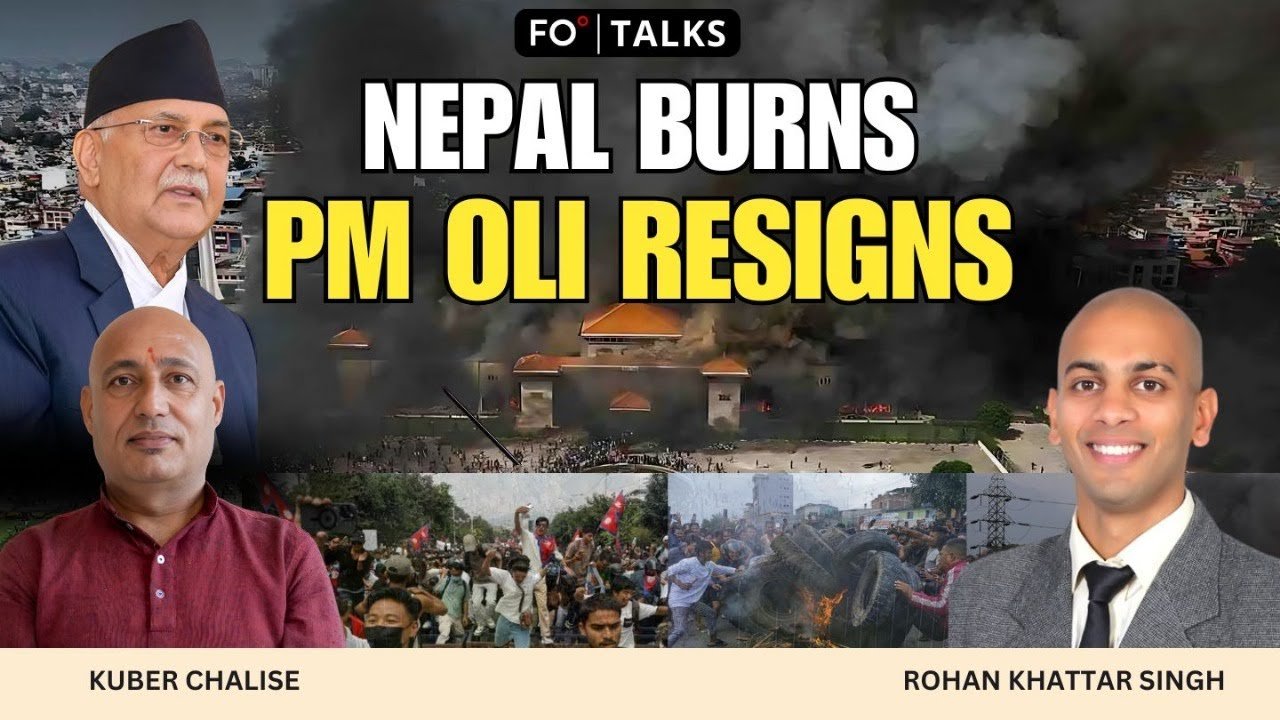
FO° Talks: Nepal’s Prime Minister Oli Resigns After Deadly Protests, What Next?

David Tizzard”
post_date=”October 11, 2025 04:59″
pUrl=”https://www.fairobserver.com/politics/fo-talks-how-impeachments-scandals-and-corruption-shaped-south-koreas-politics/” pid=”158557″
post-content=”
Editor-in-Chief Atul Singh and academic & author David Tizzard explore South Korea’s turbulent political landscape, its regional alignments and the social and cultural issues shaping the country. Tizzard stresses that while South Korea is often in the global spotlight for cultural exports, its political challenges deserve closer attention.
The discussion begins with the impeachment of former President Yoon Suk Yeol. He was found guilty of violating the Constitution after attempting to impose martial law. Citizens responded by peacefully flooding the streets, demonstrating their democratic resolve. Their protests led to Yoon’s removal and the inauguration of President Lee Jae Myung from the Democratic Party in June.
This transition demonstrates the resilience of South Korea’s democracy, established only in 1988. Tizzard adds a vivid analogy, describing the country as “a 15-year-old with a PhD” — young and turbulent, but remarkably accomplished. Despite scandals, everyday life functions efficiently, with safe public spaces, reliable hospitals and strong education systems.
South Korea & Japan
Singh turns the conversation toward foreign policy, which he and Tizzard describe as the dividing line in Korean politics. The conservative camp, which Yoon represented, traditionally leans toward Washington and Tokyo. Conservatives highlight shared democratic values while maintaining a tough stance against Beijing, China’s capital, and North Korea’s capital of Pyongyang. Yet Yoon faced criticism for being “too nice to Japan,” a sore point given Japan’s 1910–1945 colonization of Korea.
The Democratic Party, by contrast, historically favored closer ties with Beijing and Pyongyang. All Democratic presidents, from Kim Dae-jung to Moon Jae-in, met North Korean leaders. They also often pursued tense relations with Tokyo, framing Japan as a historical adversary. For decades, these alignments defined Korea’s internal debates more than domestic issues.
Lee, however, has surprised many with pragmatism. Though a Democrat, he was prepared to visit Tokyo before Washington — an unheard-of move for his party. This suggests an effort to move beyond Cold War patterns. Tizzard adds that Lee “played his hand very well” with tariffs under former US President Donald Trump, winning favorable deals despite South Korea’s reliance on the United States.
Cost-of-living crisis
Singh shifts the conversation to economics. South Korea faces a severe cost-of-living crisis alongside plummeting fertility rates. Tizzard emphasizes these are not uniquely Korean problems, but part of a global issue afflicting developed economies.
To stimulate growth, Lee handed every citizen 150,000 won (roughly $106). His platform resembles the centrist economics of UK Prime Minister Tony Blair or US President Bill Clinton, prioritizing growth and stability over ideology.
South Korea has experienced a remarkable economic journey. Once one of the poorest countries in 1953, it is now an advanced industrial power producing cars, ships, semiconductors and smartphones. But Tizzard warns that the “East Asian tiger” model is creaking under global pressures.
Demographics pose another obstacle. With the world’s lowest fertility rate, far beneath even Japan, South Korea faces population decline. Homogeneity, limited immigration and low levels of teenage or out-of-wedlock births compound the challenge. Tizzard argues that intervention often backfires, citing China’s one-child policy, and suggests Korea may be better off ignoring its example. He frames these as “First World problems” that reflect how far the nation has come since its devastation in the 1950s.
Tensions with North Korea
Singh steers the discussion toward North Korea. Lee departs sharply from Yoon’s confrontational rhetoric, which included drones and loudspeaker propaganda. Instead, he avoids calls for unification or harsh demands, settling for managing the relationship pragmatically.
Tizzard characterizes North Korea as a communist monarchy modeled on Stalinism, while speculating that North Korean dictator Kim Jong Un himself may not actually want to hold power. Yet the peninsula’s division remains politically convenient. Conservatives, Democrats, Beijing and Pyongyang all tacitly accept the status quo. Singh compares this to Germany and Ireland, where unification fears hinge more on costs than principle. Both speakers agree that reunification may no longer be realistic.
Polarization in South Korea
Turning inward, Singh highlights the volatility of South Korean politics. Former presidents often end up in jail on corruption charges, reflecting both accountability and a cycle of vendetta. In the 1990s, President Kim sought to break this cycle by inviting his political enemies — even those who once tried to kill him — to his inauguration.
Tizzard underscores how polarization today is worsened by social media, which fragments opinion and deepens divides. This is not uniquely Korean but mirrors global democratic challenges. Still, the willingness of citizens to mobilize peacefully shows that beneath the drama lies a resilient culture of democracy.
Religion in South Korea
Religion is not a political battleground in South Korea. Despite ethnic homogeneity, the country hosts diverse traditions: Buddhism, Confucianism, Christianity and shamanism. Tizzard points out that, unlike the Abrahamic West, East Asian thought lacks a central Satan figure. Religion in Korea often serves as community support and a form of mental healthcare.
As secularization advances, people increasingly invest their faith elsewhere — in political leaders, celebrities or even K-pop stars. Singh suggests this reflects broader cultural patterns, where modern societies relocate the sacred outside traditional institutions.
A new world
Tizzard closes the discussion with philosophy. He invokes Italian philosopher Antonio Gramsci’s observation: “The old world is dying, and the new world struggles to be born: Now is the time of monsters.” Singh and Tizzard agree that while democracy and capitalism have been successful in South Korea, they may no longer function as effectively as before. Rising inequality and social strain signal that the model needs rethinking.
Yet they see hope. With one of the world’s most educated, technologically adept populations, South Korea could play a role in shaping the “new world” Gramsci envisioned. Its struggles with politics, demographics and economics may, paradoxically, position it as a pioneer of future solutions.
[Lee Thompson-Kolar edited this piece.]
The views expressed in this article/video are the author’s own and do not necessarily reflect Fair Observer’s editorial policy.
”
post-content-short=”
Editor-in-Chief Atul Singh and academic & author David Tizzard explore South Korea’s turbulent political landscape, its regional alignments and the social and cultural issues shaping the country. Tizzard stresses that while South Korea is often in the global spotlight for cultural exports,…”
post_summery=”In this episode of FO° Talks, Atul Singh and David Tizzard discuss South Korea’s turbulent politics, including the impeachment of President Yoon Suk Yeol and the election of President Lee Jae Myung. The country faces domestic challenges, like a cost-of-living crisis, the world’s lowest fertility rate and deep political polarization. Fortunately, however, South Korea’s technologically advanced society could change the world.”
post-date=”Oct 11, 2025″
post-title=”FO° Talks: How Impeachments, Scandals and Corruption Shaped South Korea’s Politics” slug-data=”fo-talks-how-impeachments-scandals-and-corruption-shaped-south-koreas-politics”>
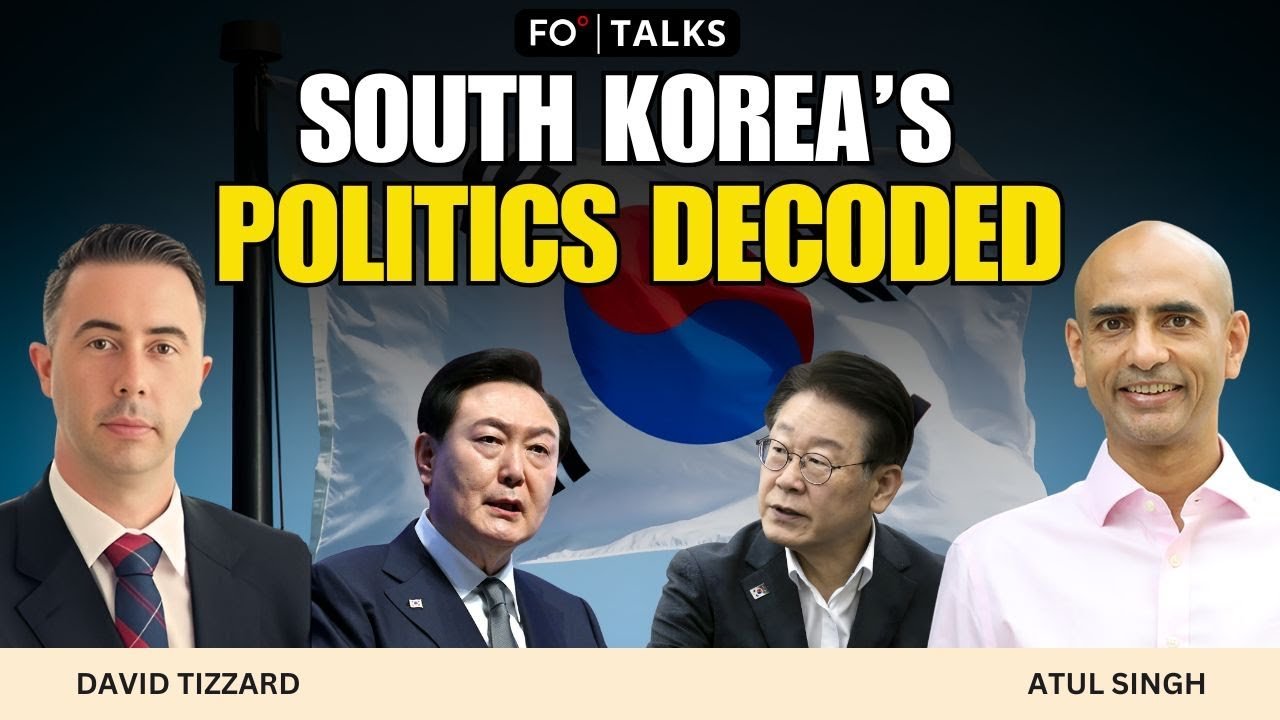
FO° Talks: How Impeachments, Scandals and Corruption Shaped South Korea’s Politics

Sebastian Schäffer”
post_date=”October 10, 2025 05:37″
pUrl=”https://www.fairobserver.com/video/fo-talks-moldovas-pro-eu-party-wins-pivotal-election-a-turning-point-or-trouble-ahead/” pid=”158526″
post-content=”
Editor-in-Chief Atul Singh and Sebastian Schäffer, the Director of the Institute for the Danube Region and Central Europe, unpack Moldova’s parliamentary elections on September 28, 2025. They analyze the geopolitical struggle shaping the small but strategically vital state between Europe and Russia.
Moldova’s election
The vote was a defining moment: In 2025, Moldova appeared to choose Europe over Russia. Sebastian calls it a surprise victory for the Party of Action and Solidarity (PAS), which defended its majority despite predictions of a hung parliament. The patriotic bloc of socialists and communists made it back into parliament. Our Party President Renato Usatîi, the Alternative Bloc and the Democracy at Home Party were newly elected, the latter boosted by social-media populism and calls for reunification with Romania.
Sebastian notes that while Moldova is a parliamentary republic, politics remain centered on Moldovan President Maia Sandu, the face of PAS, whose leadership since 2020 has reoriented the country toward Europe. Moldova’s proportional system turned PAS’s slim majority into 55 of 101 seats, signaling voters’ preference for continued integration with the European Union.
Moldova’s significance
With a population of 2.4 million, Moldova is a small, landlocked country between Romania and Ukraine. However, its political fate reverberates beyond its borders. At independence in 1991, the population was nearly double, and mass emigration has hollowed out the workforce. Many Moldovans work abroad — some in Russia, others in the EU. They send home remittances that sustain the economy, but this work situation deepens brain drain within Moldova.
Sebastian observes that skilled migrants are among the most mobile, often holding dual citizenship through Romanian or Russian passports. He argues that Moldova’s pro-European path resonates with these voters abroad, who hope European standards will let them return to a more prosperous homeland.
Is Moldova divided?
Moldova’s society is ethnically and politically diverse. The eastern separatist de facto state of Transnistria and the southern autonomous region of Gagauzia consistently vote for pro-Russian parties. Transnistria, a breakaway region since the early 1990s, hosts Russian troops and oligarch-run conglomerates such as Sheriff, which depend on cheap Russian gas to produce electricity sold to the Moldovan capital of Chișinău. Sebastian stresses that economic self-interest outweighs ideology there: Transnistria exports mostly to the EU despite its pro-Moscow stance.
Gagauzia, by contrast, shows a stronger ideological alignment with Russia. The Turkic-speaking population opposes EU membership and favors close ties, or even union, with Moscow. These internal fractures mirror Moldova’s broader polarization, complicating efforts to maintain unity.
The importance of Transnistria
Transnistria’s unresolved status remains central to Moldova’s security and European aspirations. Russian troops stationed there since 1992 now sit isolated, cut off from reinforcements by Ukraine’s resistance along the Black Sea. For Moscow, controlling the major Ukrainian seaport of Odesa would reopen a land bridge to Transnistria, but that ambition has failed.
The region’s hybrid character — a mix of criminal enterprise, oligarchic networks and dependence on Russian subsidies — makes it both a strategic foothold and a liability. Any EU accession for Moldova must address reintegration or peaceful coexistence with this frozen conflict.
Russia’s intentions and actions
Atul and Sebastian outline the Kremlin’s interference during the campaign. Moldova’s government alleged that Russia spent $200 million, 1% of GDP, on disinformation and voter bribery. On election day, bomb scares disrupted polling stations for expatriates in Italy, Romania, Spain and the United States. Authorities also accused a Russian bank of funneling illicit funds to Moldovans in pro-Russian regions.
Sebastian argues that Russia’s goal is not ideology but control: keeping Moldova in its sphere of influence and preventing another EU-aligned democracy. Moscow financed banned oligarch Ilan Shor’s party, the Șor Party, and orchestrated vote-buying in 2024. Though Moldovan police cracked down, requiring citizens to admit selling votes was illegal, Russia’s influence networks remain. Atul notes that such practices plague many poorer democracies, turning populist promises into corruption tools.
Moldova’s opposition
The opposition accused PAS of fearmongering, censorship and manipulation. They decried the closure of opposition television channels and reduced voting sites for Transnistrians, some of whom faced long queues when bridges into Moldova were closed.
Sebastian defends the government’s restrictions as safeguards for electoral integrity, arguing that international observers validated the vote’s fairness. He concedes, however, that PAS’s dominance leaves little room for alternative pro-European parties — an unhealthy concentration of power that could stifle pluralism.
EU influence
PAS campaigned on “EU by 2028,” promising to complete the acquis communautaire — the adoption of EU laws — within three years. Sebastian calls this ambitious but possible, given Moldova’s small size and its shared language with Romania. Integrating a country with slightly more inhabitants than Vienna, he argues, should be manageable.
Still, public opinion in core EU states like Austria and France has grown skeptical of enlargement. Sebastian warns that if Moldova meets every condition but Brussels hesitates, it could mark “the end of European enlargement.” Atul suggests it would halt expansion, not integration, but both agree Europe’s credibility is on the line.
Will Moldova join the EU?
The debate closes on the larger geopolitical stakes. Atul asks whether Moldova has become the newest arena of the Great Game between Europe and Russia. Sebastian answers, “Yes and no.” He notes that Russia today is capitalist but politically authoritarian, seeking czar-like control rather than ideological supremacy. The EU, by contrast, represents pluralism and the rule of law.
Sebastian frames the contest as a struggle between a free, democratic Europe and an authoritarian one. Though small in population, Moldova stands at the frontline of that struggle. PAS’s victory gives it a mandate to pursue a European future, but success will depend equally on whether the EU itself delivers.
[Lee Thompson-Kolar edited this piece.]
The views expressed in this article/video are the author’s own and do not necessarily reflect Fair Observer’s editorial policy.
”
post-content-short=”
Editor-in-Chief Atul Singh and Sebastian Schäffer, the Director of the Institute for the Danube Region and Central Europe, unpack Moldova’s parliamentary elections on September 28, 2025. They analyze the geopolitical struggle shaping the small but strategically vital state between Europe and…”
post_summery=”In this episode of FO° Talks, Atul Singh and Sebastian Schäffer discuss Moldova’s 2025 parliamentary election, exploring the country’s struggle between European integration and Russian influence. The vote delivered a decisive victory for Moldovan President Maia Sandu’s pro-EU Party of Action and Solidarity, reaffirming Moldova’s European path. Moldova now stands as a frontline test for EU credibility and expansion.”
post-date=”Oct 10, 2025″
post-title=”FO° Talks: Moldova’s Pro-EU Party Wins Pivotal Election: A Turning Point or Trouble Ahead?” slug-data=”fo-talks-moldovas-pro-eu-party-wins-pivotal-election-a-turning-point-or-trouble-ahead”>
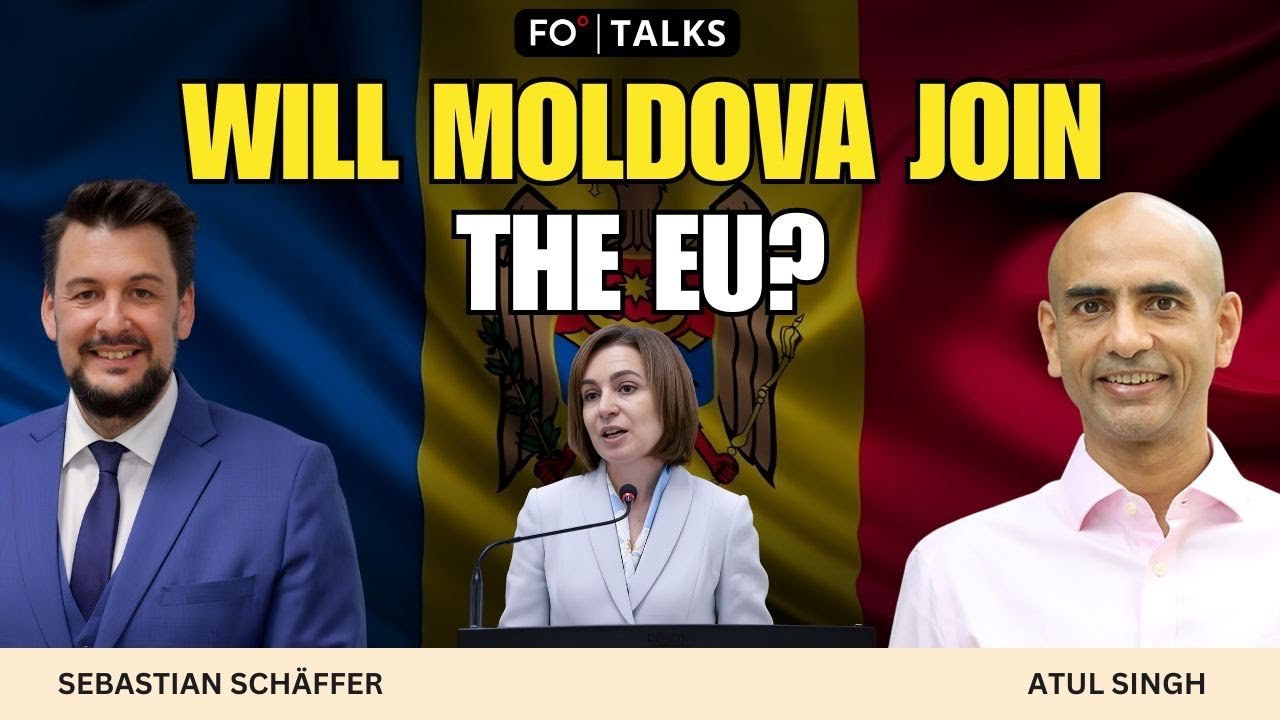
FO° Talks: Moldova’s Pro-EU Party Wins Pivotal Election: A Turning Point or Trouble Ahead?

Anna Mays”
post_date=”October 09, 2025 05:46″
pUrl=”https://www.fairobserver.com/video/fo-talks-gen-zs-anti-left-shift-women-turn-to-conservative-and-religious-lifestyle/” pid=”158509″
post-content=”
Rohan Khattar Singh, Fair Observer’s Video Producer & Social Media Manager, speaks with Anna Mays, a Young Voices contributor, about why American women from Generation Z are turning away from progressive politics and adopting cultural conservatism. They highlight disillusionment with the promises of the left, the appeal of traditional lifestyles and the growing influence of faith and social media.
Gen Z women ditch the left
Mays defines the left as a broad progressive ideology in American life that puts emphasis on deconstructing the family, expanding government programs, prioritizing autonomy and dismantling gender norms. For many Gen Z women, this has not delivered the joy and community it promised.
Her generation was taught that success meant avoiding family life and focusing on careers, yet many young women feel burnt out and lonely. Rejecting hookup culture and following traditions like motherhood now appear more fulfilling.
Khattar Singh observes that Gen Z women are unhappy with the lives they were told to live. Polling shows higher rates of anxiety and dissatisfaction compared to earlier generations. Mays sees no coincidence that this group is both the most progressive and the least happy. She emphasizes that this discontent is not abstract but rooted in lived daily experience — stress, shallow relationships and lack of support. It is this gap between theory and reality, she argues, that fuels the search for new options.
A lifestyle shift to the right
Mays stresses that the change is mainly cultural, not political. Many still vote for the left, but their lives move right. A gap has opened between how women live and the political ideals they once embraced.
She notes that lifestyle often precedes political realignment. As people gain work and family experience, they tend to lean conservative. Many find it difficult to sustain a life where daily choices contradict political beliefs.
Still, Mays emphasizes that the motivation is not partisan. Women are searching for more fulfilling lives, with politics sometimes adjusting later. Over time, she suggests, this widening gap could create significant pressure on traditional party loyalties. The small cultural choices of today — rejecting hookup culture, prioritizing family, choosing faith — may become the political dividing lines of tomorrow.
What the left lacks
Mays argues the left promises autonomy but fails to deliver community. Rhetoric about liberation rings hollow when the outcome is fractured relationships and widespread mental health struggles.
When freedom produces isolation, people conclude: This is not happiness. Cultural conservatism fills that void by offering purpose and rootedness, even when it cuts against cultural expectations.
Role of social media
Conservative influencers on the social media platforms TikTok, Instagram and YouTube are gaining millions of followers by blending lifestyle content with cultural critique. Many highlight their Christian faith. For audiences tired of progressive ideals, this creates an appealing package: clear morals, joy and stability. Whether or not viewers adopt Christianity, they are drawn to the consistency.
She believes this is more than a passing fad. Real lifestyle changes like embracing motherhood will likely outlast viral cycles. These influencers are not just creating content; they are modeling an alternative way of life that resonates with millions of young women who crave stability and meaning.
Is the world moving right?
Khattar Singh asks whether this is global. Mays points to Sweden, where young women influenced by conservative voices embrace slow living and traditional roles.
While the trend is most visible in the West, where progressive ideas are strongest, such change is stirring elsewhere. In regions where the family remains strong, like other parts of Europe and India, the shift is less obvious but still present. This suggests that cultural conservatism is part of a larger international pattern, not just an American backlash.
The feminism dying?
Mays credits early feminism for expanding rights but argues it was later hijacked. Instead of celebrating feminine roles, it encouraged women to adopt masculine-coded behaviors — full-time work and a rejection of motherhood.
She calls for a new feminine movement that validates choices beyond the “girlboss” archetype. Khattar Singh agrees this turn toward tradition and religion warrants close attention. They stress that this is not a retreat from progress, but a demand for broader definitions of fulfillment and success that resonate with women’s lived experiences.
[Lee Thompson-Kolar edited this piece.]
The views expressed in this article/video are the author’s own and do not necessarily reflect Fair Observer’s editorial policy.
”
post-content-short=”
Rohan Khattar Singh, Fair Observer’s Video Producer & Social Media Manager, speaks with Anna Mays, a Young Voices contributor, about why American women from Generation Z are turning away from progressive politics and adopting cultural conservatism. They highlight disillusionment with the…”
post_summery=”In this episode of FO° Talks, Rohan Khattar Singh and Anna Mays examine why Gen Z women are leaving progressive politics for right-aligned lifestyles. Disillusionment with autonomy and burnout has pushed many toward traditional roles, faith and community. Social media influencers amplify this shift, raising questions about feminism, politics and the global spread of cultural conservatism.”
post-date=”Oct 09, 2025″
post-title=”FO° Talks: Gen Z’s Anti-Left Shift: Women Turn to Conservative and Religious Lifestyle” slug-data=”fo-talks-gen-zs-anti-left-shift-women-turn-to-conservative-and-religious-lifestyle”>
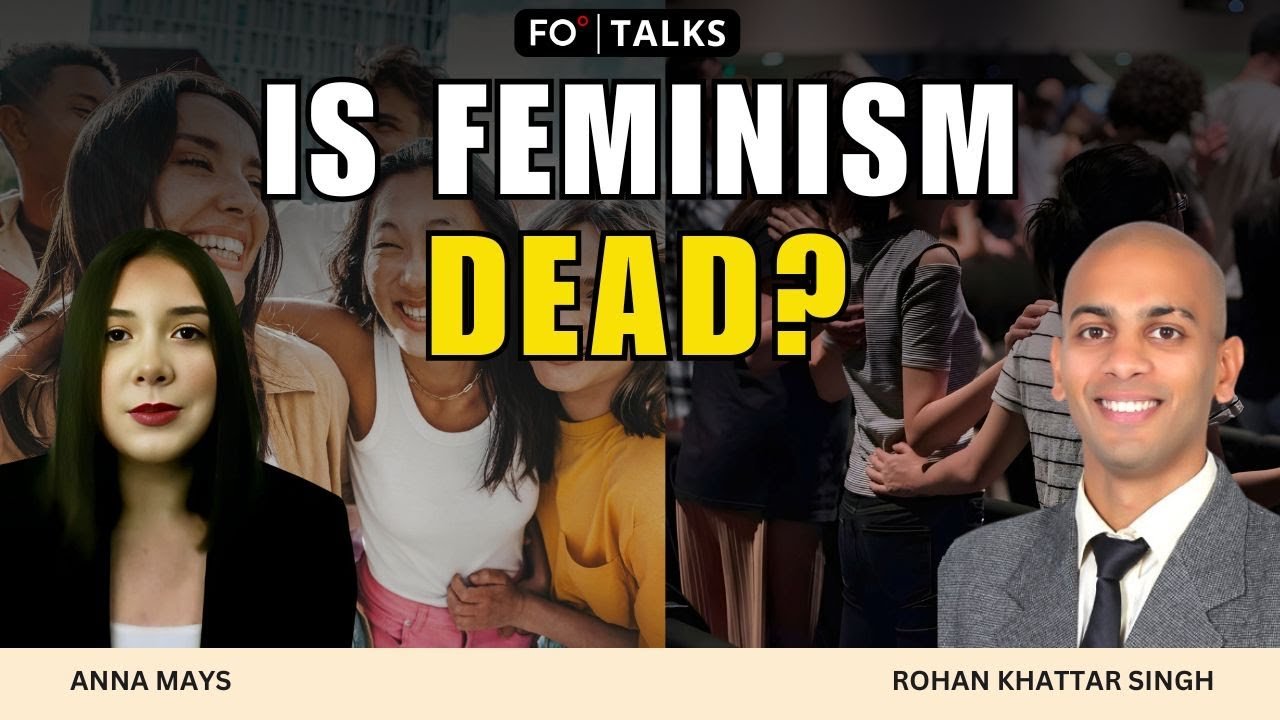
FO° Talks: Gen Z’s Anti-Left Shift: Women Turn to Conservative and Religious Lifestyle

Anna Mays”
post_date=”October 08, 2025 07:24″
pUrl=”https://www.fairobserver.com/video/fo-talks-netflix-and-nfl-are-more-popular-than-church-gen-z-moving-away-from-religion/” pid=”158492″
post-content=”
Rohan Khattar Singh, Fair Observer’s Video Producer & Social Media Manager, speaks with Anna Mays, a Young Voices contributor. Together, they examine the decline of Christian church attendance in the United States. They compare organized religion with cultural giants like the National Football League (NFL) and streaming platforms, asking whether these have become the “new sacred.”
Mays argues that the church’s future depends on returning to its core mission rather than competing with entertainment. She believes that faith institutions must rediscover their unique strengths — spiritual nourishment, moral teaching and genuine community — rather than imitating the tactics of consumer culture. This rediscovery could allow the church to thrive in a distracted age.
NFL > church?
Mays begins with a provocative analogy: For many Americans, NFL Sundays are treated as more sacred than church. Football fans show extraordinary commitment — showing up weekly, dressing the part and investing emotionally. Yet church attendance has collapsed, with only about 20% of Americans attending weekly.
What does American society truly value: religion or sports? Mays argues that the NFL, Netflix or even a restful couch should never outrank God. For her, the highest human purpose is being in relationship with God, and church services should stand above all other options.
Church in the digital age
Khattar Singh ponders if the digital age explains the decline. Mays disagrees, saying the problem is not too many choices but the church’s attempt to compete with them. Churches that try to “out-Netflix Netflix” or “out-comfort the couch,” she says, will always lose. The church must remain focused on worship and community rooted in Jesus Christ.
She critiques the trend of overly comforting sermons that dilute the gospel into palatable slogans. Asked if the church has fallen behind technologically, Mays responds that the issue is preferences, not platforms. People shaped by TikTok’s eight-second clips prefer distraction over prayer or scripture.
The solution, Mays insists, is not imitation but reordering priorities toward what is fulfilling and eternal. In her framing, digital tools can be helpful, but they must never become substitutes for the deeper calling of discipleship, which cannot be compressed into a short video or a catchy headline.
Church vs trends
While many churches have weakened, Mays sees others holding true to biblical mandates. She points to Generation Z as evidence: Many are leaving progressive denominations that emphasize comfort and instead gravitating toward more orthodox practices, such as the Latin Mass.
She cites data showing the Presbyterian Church USA lost over 140 congregations and 150,000 members in a single year, while the United Methodist Church is experiencing a historic fracture. Mays interprets these developments as evidence that her generation has discovered cultural success and social media does not lead to happiness. Instead, they are drawn to the “what is true, what is good and what is more beautiful” — which, as scripture says, is God.
Why is the NFL so popular?
Khattar Singh highlights the NFL’s enormous cultural footprint, noting that stars like quarterback Tom Brady and tight end Rob Gronkowski enjoy global recognition. Mays agrees, situating football alongside figures like singers Taylor Swift or Beyoncé.
She reflects on how the community has been redefined. It once meant neighbors who worshiped with you and cared for you in need. Now, community is often based on hobbies or fandoms. While not inherently bad, such loyalties become harmful if they take precedence over God. To illustrate, she recalls the Israelites’ golden calf and philosopher Plato’s warnings about misordered priorities. Khattar Singh remarks that the NFL has built loyalty that the church has failed to match.
What next for the church?
Asked how the church can reach Generations Z and Alpha, Mays offers three points: First, it must proclaim the full gospel without watering it down. People, she argues, are drawn to truth, and the Bible speaks to that desire.
Second, it must move away from seeker-sensitive movements and shallow sermons. While Jesus says “come as you are,” Mays stresses he never said “stay as you are.” The mission is to make disciples who make disciples.
Finally, Mays emphasizes prayer and reliance on God. Christians should embrace their weakness in comparison to God’s strength. This humility, she argues, is the foundation of a stronger church able to gain new “souls for heaven.” If the church remembers that success is measured not in numbers or popularity but in faithfulness, it may regain credibility and inspire future generations to build lasting communities of hope and devotion.
[Lee Thompson-Kolar edited this piece.]
The views expressed in this article/video are the author’s own and do not necessarily reflect Fair Observer’s editorial policy.
”
post-content-short=”
Rohan Khattar Singh, Fair Observer’s Video Producer & Social Media Manager, speaks with Anna Mays, a Young Voices contributor. Together, they examine the decline of Christian church attendance in the United States. They compare organized religion with cultural giants like the National…”
post_summery=”In this episode of FO° Talks, Rohan Khattar Singh and Anna Mays discuss the decline of church attendance in the United States and the cultural dominance of the NFL and streaming services. Mays believes that Christian churches should not imitate entertainment trends but return to their Biblical mission, renewing focus on truth, discipleship and prayer.”
post-date=”Oct 08, 2025″
post-title=”FO° Talks: Netflix and NFL Are More Popular Than Church, Gen Z Moving Away From Religion?” slug-data=”fo-talks-netflix-and-nfl-are-more-popular-than-church-gen-z-moving-away-from-religion”>

FO° Talks: Netflix and NFL Are More Popular Than Church, Gen Z Moving Away From Religion?

Martin Plaut”
post_date=”October 07, 2025 05:44″
pUrl=”https://www.fairobserver.com/history/fo-talks-the-5000-year-secret-history-of-african-slavery-they-dont-teach-you/” pid=”158479″
post-content=”
Martin Plaut, a journalist, academic and author, delivers a sweeping historical account of African enslavement across five millennia, tracing its global routes, atrocities and lasting legacies. He further highlights its brutality and enduring impact.
Plaut opens with a quote from former African American slave Elizabeth Freeman: “Any time while I was a slave, if one minute’s freedom had been offered to me, and I had been told I must die at the end of that minute, I would have taken it — just to stand one minute on God’s earth a free woman — I would.” For Plaut, this testimony captures the essence of slavery’s horror and the immeasurable value of freedom.
The transatlantic trade
Plaut turns to the transatlantic slave trade, which lasted from 1444 to the 1850s. While the outlines are familiar, he emphasizes that tens of thousands also came from Portuguese and East Africa, some reaching the United States. Captors included Portuguese, British, French, Danish and others, each profiting from the vast human traffic.
He recalls the infamous Zong incident of 1781, which he calls “possibly the worst thing, the worst event of all.” The captain of the slave ship Zong claimed to be running out of water and threw 133 slaves overboard alive. The event became known only through a court case — an insurance dispute over “lost cargo.” To Plaut, the fact that human life was reduced to a financial claim demonstrates slavery’s cruelest logic.
Ancient and Islamic dimensions
Plaut observes that the enslavement of Africans predates the Atlantic system. Egyptian slavery along the Nile lasted centuries. After Muhammad’s death, Arab armies swept into Egypt, across North Africa and into Spain and Portugal. This conquest fueled Mediterranean and trans-Saharan trades, sometimes reaching as far as China. Large numbers, especially from Sudan and Ethiopia, were taken across the Red Sea to the Saudi Arabian city of Mecca, Iraq and Syria. These routes endured for generations, shaping populations far from Africa’s shores.
Plaut notes how enslaved Africans, usually men, were taken to India as military slaves. He cites military leader Malik Ambar, a slave from Ethiopia who defeated two Mughal emperors. Descendants remain in India and Pakistan, often called the Siddi ethnic group. Plaut comments that they “all have a pretty tough time of it,” reflecting on their marginalized status in modern society.
The Indian Ocean trade
He describes the Indian Ocean trade dominated by the Omanis. Beginning in the first century CE, it later expanded with Portuguese, Dutch and British involvement. Omanis relied on Indian merchants and financiers to organize activities and mercenaries from the Baloch ethnic group. The wealth was so immense that the Omani Sultanate moved its capital from Muscat in Oman to the Tanzanian archipelago of Zanzibar, a symbol of slavery’s financial engine.
Plaut highlights Afro-Omani ivory and slave trader Tippu Tip, whose name echoed the sound of his guns. He cites the 1866 account of Edward Seward, the British consul in Zanzibar, who saw a caravan of 300 slaves. Purchased for mere cotton cloth, they marched nine hours daily and were fed only boiled sorghum and water. Men were bound in forked sticks; women and children were tied by the hands. Seward described children beaten to death and paths littered with corpses, a haunting record of human misery.
Enslavement in modern times
Plaut discusses slavery that continued into the twentieth century, showing a 1935 image of Ethiopian merchants and their slaves delivering money to Ethiopian Emperor Haile Selassie for his war against Italy. This, he observes, is an aspect of Selassie’s reign “not much commented on.”
The Sokoto Caliphate
Plaut explores the Sokoto Caliphate, an Islamic state that lasted a century and comprised 30 emirates from Cameroon to Burkina Faso. In the mid-nineteenth century, Sokoto may have held as many slaves as the four million in the US on the eve of its Civil War. Plaut finds it “extraordinary that something of such importance has somehow been missed.”
Measuring the catastrophe
Plaut estimates that across five millennia, “at least 50 million Africans” were enslaved. He also notes that present-day conflict zones often align with old slave routes. He suggests slavery’s destructive legacy persists.
Chains unbroken
Plaut ends with the image of former US President Barack and former First Lady Michelle Obama at the Door of No Return on Gorée Island, Senegal, in 2013. He calls it “extraordinarily uplifting” and proof that “injustice is not imprinted on history.” His talk, drawn from his book, Unbroken Chains: A 5,000-Year History of African Enslavement, reminds us that slavery’s story is ancient, tragic and still echoing.
[Lee Thompson-Kolar edited this piece.]
The views expressed in this article/video are the author’s own and do not necessarily reflect Fair Observer’s editorial policy.
”
post-content-short=”
Martin Plaut, a journalist, academic and author, delivers a sweeping historical account of African enslavement across five millennia, tracing its global routes, atrocities and lasting legacies. He further highlights its brutality and enduring impact.
Plaut opens with a quote from former African…”
post_summery=”In this episode of FO° Talks, Martin Plaut traces five millennia of African enslavement, beginning with the Atlantic trade before exploring earlier Egyptian, Islamic and Indian systems. He highlights the Indian Ocean trade and the Sokoto Caliphate’s vast slave population across West Africa. Slavery has taken a staggering human toll, and its legacy endures.”
post-date=”Oct 07, 2025″
post-title=”FO° Talks: The 5,000-Year Secret History of African Slavery They Don’t Teach You” slug-data=”fo-talks-the-5000-year-secret-history-of-african-slavery-they-dont-teach-you”>
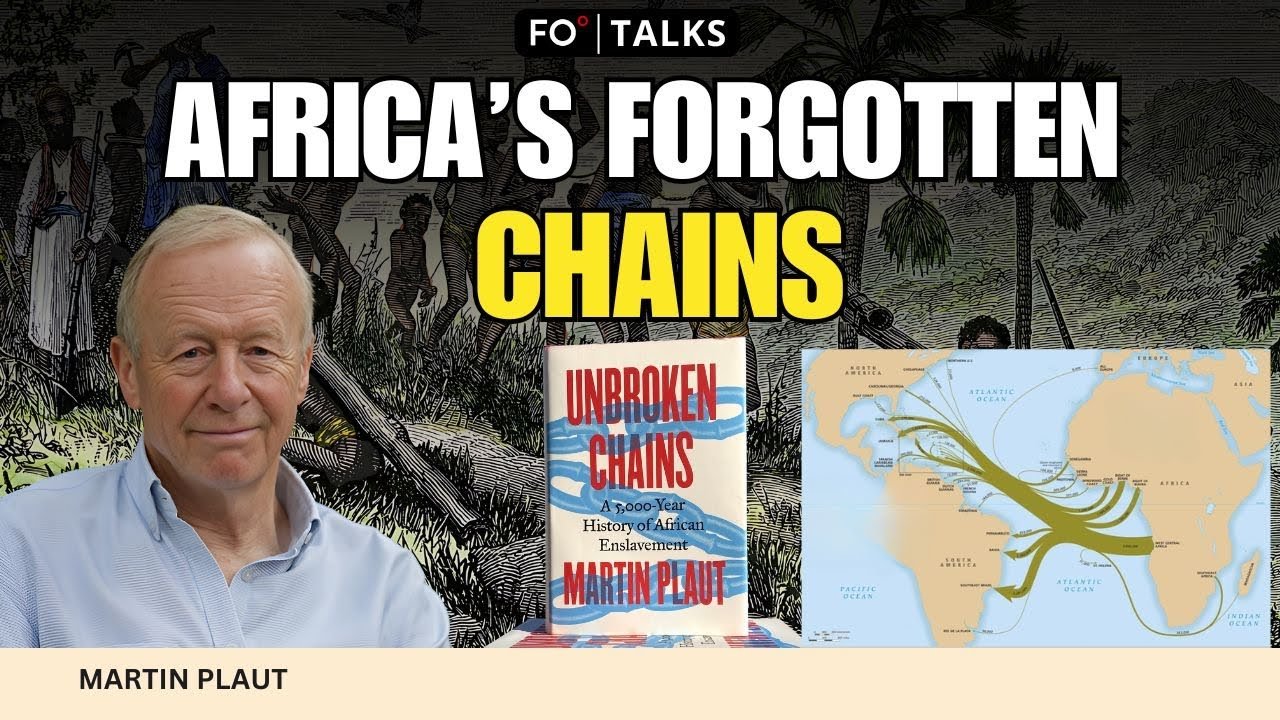
FO° Talks: The 5,000-Year Secret History of African Slavery They Don’t Teach You

Glenn Carle”
post_date=”October 06, 2025 06:24″
pUrl=”https://www.fairobserver.com/economics/fo-exclusive-economic-pain-and-political-turmoil-around-the-world/” pid=”158464″
post-content=”
Editor-in-Chief Atul Singh and retired CIA Officer Glenn Carle analyze economic pain and political turmoil across the globe. The US is not unique in facing division and stagnation; decades of sluggish growth and rising inequality have left citizens frustrated, and in recent months, protests and government crises in several major countries have toppled leaders and fueled new uncertainty.
Atul underscores that revolutions correspond with the price of bread or rice in the case of Asia. Per capita growth over the last two decades has been dismal: just 0.6% in the UK and 0.7% in both France and Japan. These averages mask the fact that most of the benefits have gone to a small elite, while the majority have seen declining living standards. Glenn stresses that when growth slows and inequality rises, citizens look for scapegoats — often immigrants, rivals abroad or their own leaders.
Japan’s cost-of-living crisis
Japan exemplifies how economic strain destabilizes politics. Inflation reached 3.2% in January, while the price of rice doubled. Outrage grew after a cabinet minister joked about rice, forcing his resignation.
The ruling Liberal Democratic Party has lost its grip, failing to win majorities in both houses of parliament. Prime Minister Shigeru Ishiba resigned as US tariffs and regional tensions mounted. Japan now faces the prospect of its fourth prime minister in five years, a remarkable churn for a nation once considered a bastion of stability. Atul’s sources in Tokyo worry about fragmentation in Japanese politics that could hamper Japan’s response to both economic challenges and regional security threats.
France’s fiscal crisis and street protests
Meanwhile, France is caught in what Glenn calls a “perpetual crisis.” In just nine months, parliament has voted out two governments. Michel Barnier, best known for negotiating Brexit, became the prime minister but failed to win the vote of confidence in parliament. François Bayrou replaced him but quickly fell also, warning that France was “living beyond its means.” French President Emmanuel Macron then appointed loyalist Sébastien Lecornu, making him France’s fifth prime minister since 2022.
The numbers are stark: a budget deficit of 5.8%, the highest in the eurozone, and debt at 114% of GDP. Borrowing costs are climbing and markets are nervous. Bayrou warned of a Greece-style debt crisis, raising the specter of International Monetary Fund intervention. On the streets, protests have erupted, targeting both the government and economic conditions. Atul’s sources in Paris worry that polarization and fragmentation in French politics have made governments short-lived and blocked any action to address the crisis. Some analysts even question the durability of the French Fifth Republic itself.
The UK’s triple shock
The UK faces an even worse situation. Its economy was hammered by three shocks: the 2008 financial crisis, Brexit and the Covid-19 pandemic. Productivity lags behind peers, infrastructure is deteriorating and real wages have barely grown since 2008, even as debt has ballooned.
Economic pain has fed political unrest. Recently, 150,000 people marched in London under the banner of far-right activist Tommy Robinson, a far-right anti-immigration activist with several criminal convictions. Immigration, particularly illegal crossings of the English Channel, has become a lightning rod. Atul observes that contacts in London and Manchester expect the right-wing Reform UK party to build support at the expense of both the Labour Party and the Conservatives. The rise of far-right populism, combined with economic stagnation, suggests a period of deepening polarization.
The revolutions of 1848
Glenn offers a historical context to current problems, likening the current moment to the revolutions of 1848. At that time, agricultural failures created economic pain while nationalism fueled cultural unrest, sparking uprisings across Europe. Today’s economic stagnation, mixed with cultural anxiety, shows a striking parallel.
He observes that once-dominant groups, particularly in the West, feel they are losing control of their societies. Immigration often becomes the symbol of this perceived decline. Glenn adds that the concentration of wealth since the 1980s has amplified the anger. In the US, 1% of the population now controls 40% of wealth, while the bottom 80% hold just 10%. Glenn warns that inequality could undermine the legitimacy of democratic institutions, as happened earlier in Ancient Rome.
Nepal and the “nepo kids”
The crisis is not confined to developed economies. Across South Asia, popular anger has boiled over. Nepal is the latest flashpoint: High youth unemployment, falling remittances and visible corruption ignited protests led by Generation Z. Social media highlighted the lavish lifestyles of politicians’ children — dubbed “nepo kids.” Mobs stormed parliament, torched buildings and attacked party leaders.
Atul places this upheaval in a regional pattern: Sri Lanka in 2022, Pakistan in 2023 and Bangladesh in 2024 all saw mass movements that toppled or nearly toppled governments. Indian analysts fear that Nepal’s protests could spread. Although India has grown faster than its neighbors, it is not immune. Atul stresses that dissatisfaction, unemployment and inequality could spark unrest even in India, adding to the pressures businesses already face in Western markets.
The broader pattern
The recurring theme is clear: Economic pain is destabilizing political order worldwide. In the developed world, decades of low growth and high inequality have hollowed out trust in governments. In the developing world, corruption, weak institutions and youth outrage are driving upheaval.
Atul concludes that volatility will dominate the months ahead, with protests and government crises multiplying across continents. Glenn agrees, emphasizing that these are not isolated shocks but systemic pressures reshaping global politics. From Tokyo to Paris, London to Kathmandu, instability has become the new normal.
[Lee Thompson-Kolar edited this piece.]
The views expressed in this article/video are the author’s own and do not necessarily reflect Fair Observer’s editorial policy.
”
post-content-short=”
Editor-in-Chief Atul Singh and retired CIA Officer Glenn Carle analyze economic pain and political turmoil across the globe. The US is not unique in facing division and stagnation; decades of sluggish growth and rising inequality have left citizens frustrated, and in recent months, protests and…”
post_summery=”In this section of the September 2025 episode of FO° Exclusive, Atul Singh and Glenn Carle discuss how decades of inequality have fueled political turmoil worldwide. Crises in Japan, France and the United Kingdom show how debt and leadership churn destabilize governments. The unrest has spread to South Asia, with Nepal’s “Nepo kid” protests raising fears even in India.”
post-date=”Oct 06, 2025″
post-title=”FO° Exclusive: Economic Pain and Political Turmoil Around the World” slug-data=”fo-exclusive-economic-pain-and-political-turmoil-around-the-world”>
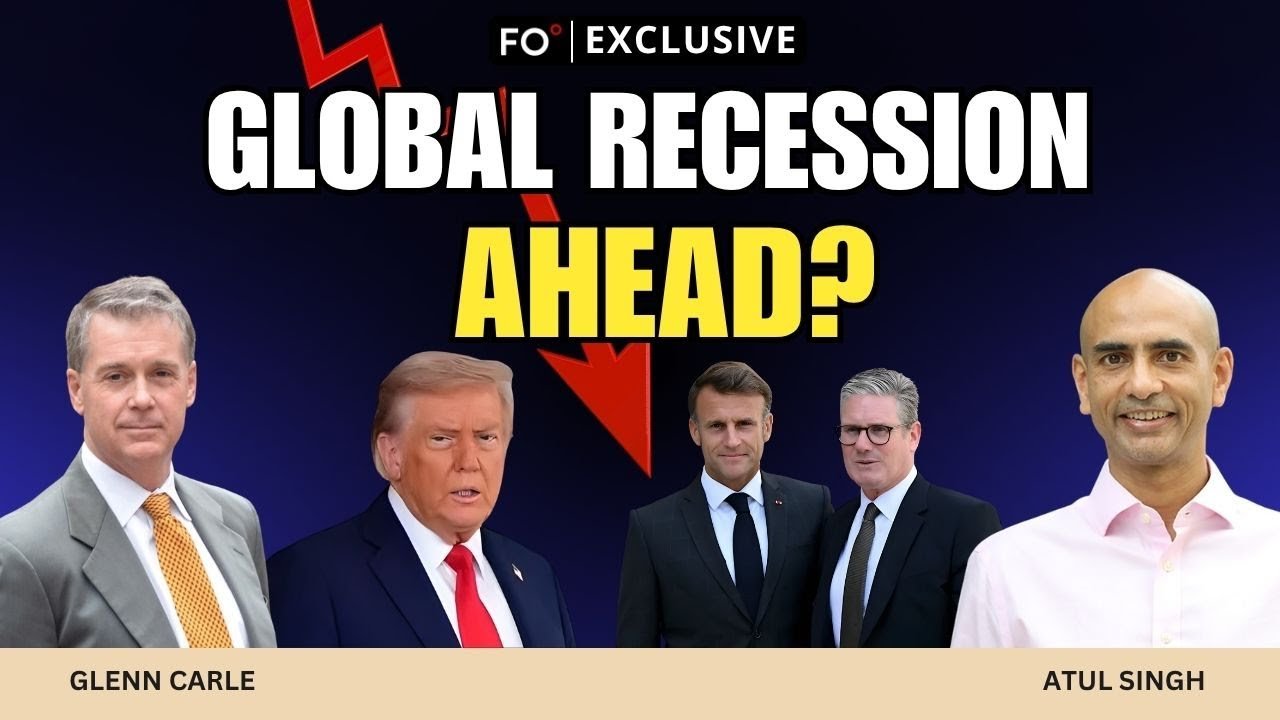
FO° Exclusive: Economic Pain and Political Turmoil Around the World

Glenn Carle”
post_date=”October 05, 2025 05:47″
pUrl=”https://www.fairobserver.com/economics/fo-exclusive-us-dollar-will-continue-to-lose-value/” pid=”158451″
post-content=”
Editor-in-Chief Atul Singh and retired CIA Officer Glenn Carle discuss how the US dollar will continue to drop in value. They analyze the economic and political factors driving this decline, blending hard data with subjective judgments. Both highlight how fiscal irresponsibility, flawed policy and shifting geopolitics are putting pressure on the world’s dominant currency.
Debt, politics and paralysis
Atul argues that the combination of trade policy, monetary policy and a growing debt crisis will force devaluation. He stresses that the Trump administration’s faith in the dollar’s unassailability is not supported by data, adding to doubts about the dollar’s status as a safe haven.
US Treasury insiders, Atul reports, admit the US will eventually be unable to service government debt in its current form. Political leadership has stopped taking debt seriously: Republicans give tax breaks, democrats expand social programs, and both ignore structural problems. Glenn reinforces the point, noting that Republicans also spend heavily, just on different items like defense. Economists across the spectrum agree that America has shown both an inability and unwillingness to address debt, which is an existential issue for the global economy.
What Atul finds most worrying is policymakers’ indifference. Trump, Treasury Secretary Scott Bessent, Commerce Secretary Howard Lutnick and democratic figures such as New York State Representative Zohran Mandani show little concern. This complacency, he predicts, will encourage investors to shift away from the dollar.
The Dollar Milkshake Theory
Atul points to the popularity of the Dollar Milkshake Theory, coined by economist Brent Johnson. It claims the dollar acts like a straw, sucking up liquidity from the global “milkshake” into dollar-denominated assets and debt. The dollar’s strength, according to this view, comes from monetary distortions and financial arbitrage, not innovation or productivity. Geopolitical turbulence supposedly boosts demand for dollars because no other asset provides the same liquidity.
Atul warns that the real world tells a different story. The dollar has depreciated against nearly all major currencies in 2025, sliding from 109.39 to 97.61 on a standard basket. Against gold, the fall has been steeper, from 376 to 270, while gold itself surged past $3,500 per troy ounce. Atul suggests the Dollar Milkshake Theory may soon collapse under evidence, likening it to the geocentric model before Renaissance astronomer Nicolaus Copernicus.
Geopolitics and shifting assets
The freeze of $300 billion in Russian assets after the 2022 invasion of Ukraine continues to echo. Atul stresses that blocking sovereign reserves has made countries like China, India and Brazil wary of keeping money in dollars. Brazilian President Luiz Inácio Lula da Silva, already tense with Washington, is a case in point.
The administration of US President Donald Trump has exacerbated the problem by imposing tariffs on allies like the United Kingdom, further undermining confidence. Central banks are diversifying into gold and silver. The German investment company Deutsche Bank reports hedged positions in US assets now outstrip unhedged ones for the first time in four years. At the start of 2025, only 20% of foreign-domiciled US equity exchange-traded funds were hedged; in the last three months, 80% of $7 billion invested has been hedged.
Major financial hubs from New York to Singapore have reached a consensus: “The hedge dollar moment has arrived.”
Fed pressure and inflation risks
The FOI Geopolitical Risk Monitor indicates that Trump and Bessent are pressuring the Federal Reserve (or Fed) to cut interest rates. The recent appointment of US Chairman of the Council of Economic Advisers Stephen Miran to the Fed’s Board of Governors underscored this shift — he dissented at the last meeting, pushing for a larger cut. These moves, Atul says, will stoke inflation and further erode the dollar. Indian exporters, he adds, risk exchange losses unless they hedge carefully.
Glenn’s economic lens
Glenn offers an alternative view. He dismisses the notion of a malign plot implied by the Dollar Milkshake Theory, framing the dollar’s decline in classical economic terms. The problem, he says, is sheer incompetence.
Despite America’s strengths — superior productivity, unmatched research and the largest market — the administration has undermined them. Glenn lists the steps: attacks on Fed independence, higher tariffs, more spending and reduced revenues. Each erodes confidence, drives inflation and weakens the dollar. He judges that “almost literally every step has eroded or challenged or undermined” US economic strength. Trump’s United Nations claim that global warming is a hoax, Glenn adds, is so disconnected from reality that it threatens the coherence of governance itself.
China, meanwhile, is steadily encouraging global trade in non-dollar denominations. Glenn concludes that the dollar will keep weakening and inflation will rise at an accelerating pace.
The future of the dollar
Atul and Glenn converge on the view that the dollar’s decline is not temporary but structural. The debt crisis, complacency, tariffs and Fed pressure all point the same way. Investors are hedging, central banks are diversifying and rivals like China are building alternatives.
The US dollar has long seemed untouchable, but its fortress is cracking. Whether the fall comes suddenly or through steady erosion, Atul and Glenn both warn that it now seems inevitable.
[Lee Thompson-Kolar edited this piece.]
The views expressed in this article/video are the author’s own and do not necessarily reflect Fair Observer’s editorial policy.
”
post-content-short=”
Editor-in-Chief Atul Singh and retired CIA Officer Glenn Carle discuss how the US dollar will continue to drop in value. They analyze the economic and political factors driving this decline, blending hard data with subjective judgments. Both highlight how fiscal irresponsibility, flawed policy and…”
post_summery=”In this September 2025 episode of FO° Exclusive, Atul Singh and Glenn Carle examine why the US dollar continues depreciating despite America’s economic strengths. Atul highlights the American debt crisis, the limitations of Dollar Milkshake Theory and global shifts toward hedging against dollar depreciation. Both point out that US President Donald Trump’s attacks on the Federal Reserve and reckless tariffs are eroding confidence in the dollar.”
post-date=”Oct 05, 2025″
post-title=”FO° Exclusive: US Dollar Will Continue to Lose Value” slug-data=”fo-exclusive-us-dollar-will-continue-to-lose-value”>

FO° Exclusive: US Dollar Will Continue to Lose Value

Glenn Carle”
post_date=”October 04, 2025 06:33″
pUrl=”https://www.fairobserver.com/politics/fo-exclusive-the-divided-not-united-states-of-america/” pid=”158428″
post-content=”
Editor-in-Chief Atul Singh and retired CIA Officer Glenn Carle explore the crumbling democratic norms in the United States. They stress that division is only the surface; the deeper crisis is the collapse of democratic consensus and the steady rise of authoritarianism on the American right. Glenn traces this trend back decades, arguing that it has been growing since the 1950s — it accelerated after 1964 and took sharper form by 1980. What emerges today is not just polarization but the ascendance of a fascist essence within the Republican Party and the religious right.
The Unbearable Lightness of political disaffection
Glenn frames the crisis with a literary analogy. He calls author Milan Kundera’s novel, The Unbearable Lightness of Being, “one of the great works of literature,” noting how it depicted life in Czechoslovakia after the Prague Spring was crushed in 1968. Citizens, stripped of agency, withdrew into gardening, music or sex, because truth itself had been destroyed.
Glenn says he senses a similar retreat in the US: A minority fervently supports US President Donald Trump while a larger percentage is “appalled.” This opposition is powerless at the national level, since the Republican Party controls the levers of government and defines truth for itself. The result is disaffection and withdrawal into private life.
Charlie Kirk’s assassination and political spectacle
The assassination of conservative activist Charlie Kirk at Utah Valley University dominates the discussion. Glenn calls the national response “astounding.” The Trump administration and the Republican Party quickly turned Kirk into a martyr, with repeated religious comparisons. Within days, more than 100,000 people filled a stadium in Glendale, Arizona, for a five-hour service that blended religious revival and a Make America Great Again rally. Atul compares the scene to televangelist events, saying the crowd seemed to be in a state of religious frenzy.
Erika Kirk, Charlie’s widow, publicly forgave her husband’s accused killer, while Trump consoled her before the audience. Political blogger Meghan McCain commented on X, “Today is the day democrats lost 2028.” Days later, Vice President JD Vance hosted Kirk’s program from the White House, showing how tragedy was instantly weaponized for politics.
Jimmy Kimmel backlash and the attack on free speech
The fallout extended into entertainment. Comedian Jimmy Kimmel expressed sympathy for the Kirk family but suggested Republicans were exploiting the death. The Walt Disney Company’s ABC television station suspended him after Federal Communications Commission Chair Brendan Carr threatened the network. Though later reinstated, many conservative-owned stations refused to air his show, branding him a blasphemer.
Glenn calls Kimmel’s comments “slightly tasteless” but not inflammatory, yet they triggered a firestorm. Atul and Glenn argue that this reveals how discourse is now defined by the far right. Free speech, guaranteed by the First Amendment, is shrinking under political intimidation. For Glenn, suppressing speech is a characteristic of totalitarian fascism.
Fractures of American discourse
Glenn highlights that many on the left barely knew who Kirk was, while on the right he had millions of young followers. Atul interprets this as evidence of alienation among students who feel they cannot speak freely on campus. He calls universities “politically correct Soviet-style Omertà” environments — “Omertà” being a Southern Italian code of silence — even describing them as modern Bolshevism.
Glenn agrees the stakes are dire: Free speech has become a “mortal threat” both to individuals and to democracy itself. He recalls being labeled Islamophobic by students simply for criticizing radical Islam. Historically, free speech protected even offensive speech unless it incited imminent violence. Glenn laments that this standard has fallen, leaving careers ruined by offending sensibilities.
The cultural battlefield between the “woke” and the “anti-woke” is equally destructive. The former demands ideological conformity in the name of inclusion, while the latter weaponizes resentment to silence opponents. This binary clash leaves little room for genuine dialogue and instead corrodes the democratic foundation that depends on pluralism and tolerance of dissent.
The definition of fascism and evangelical loyalty
Glenn then explains why conservative Christians support an authoritarian leader. Evangelicals argue that sin is inevitable and forgivable, so it does not disqualify a leader. They see leaders as vehicles, not embodiments, much like the biblical King Cyrus, who served God despite his corruption. The movement is about power: gaining the means to impose values, even if it requires loyalty over truth.
Glenn lists five factors: forgiveness of sin, strategic pursuit of power, tribal loyalty, a sense of existential threat and the willingness to use any means. He concludes this is fascism, citing the dictionary definition: a populist ideology exalting the nation and often race above individuals, led by an autocrat, enforcing regimentation and suppressing opposition. To underline the point, he quotes German theorist Carl Schmitt, who defined politics through friend-enemy distinctions, and Nazi philologist Joseph Goebbels, who said the press must never confuse the people with truth.
A democracy at the edge of survival
Glenn condemns how swiftly Kirk’s death was seized upon to demonize the “radical left.” He calls the exploitation unprecedented, comparing it to the Reichstag fire of 1933, which the Nazi Party used to cement control.
He stresses that Kirk himself opposed individual rights, sought state control over sexuality and denied women’s agency, yet is now elevated as a champion. This, Glenn argues, illustrates the existential split tearing the nation apart. He fears this crisis is worse than any in American history after the end of the Civil War in 1865 and questions whether democracy can be restored. Atul concurs that the stakes are nothing less than survival: The foundations of freedom are eroding, and what rises instead bears the hallmarks of a fascist order.
[Lee Thompson-Kolar edited this piece.]
The views expressed in this article/video are the author’s own and do not necessarily reflect Fair Observer’s editorial policy.
”
post-content-short=”
Editor-in-Chief Atul Singh and retired CIA Officer Glenn Carle explore the crumbling democratic norms in the United States. They stress that division is only the surface; the deeper crisis is the collapse of democratic consensus and the steady rise of authoritarianism on the American right. Glenn…”
post_summery=”In this September 2025 episode of FO° Exclusive, Atul Singh and Glenn Carle discuss the collapse of American democratic consensus, warning that polarization has turned dangerous. They examine the assassination of Charlie Kirk and the Jimmy Kimmel controversy. America may face its gravest existential crisis since 1865.”
post-date=”Oct 04, 2025″
post-title=”FO° Exclusive: The Divided, Not United, States of America” slug-data=”fo-exclusive-the-divided-not-united-states-of-america”>
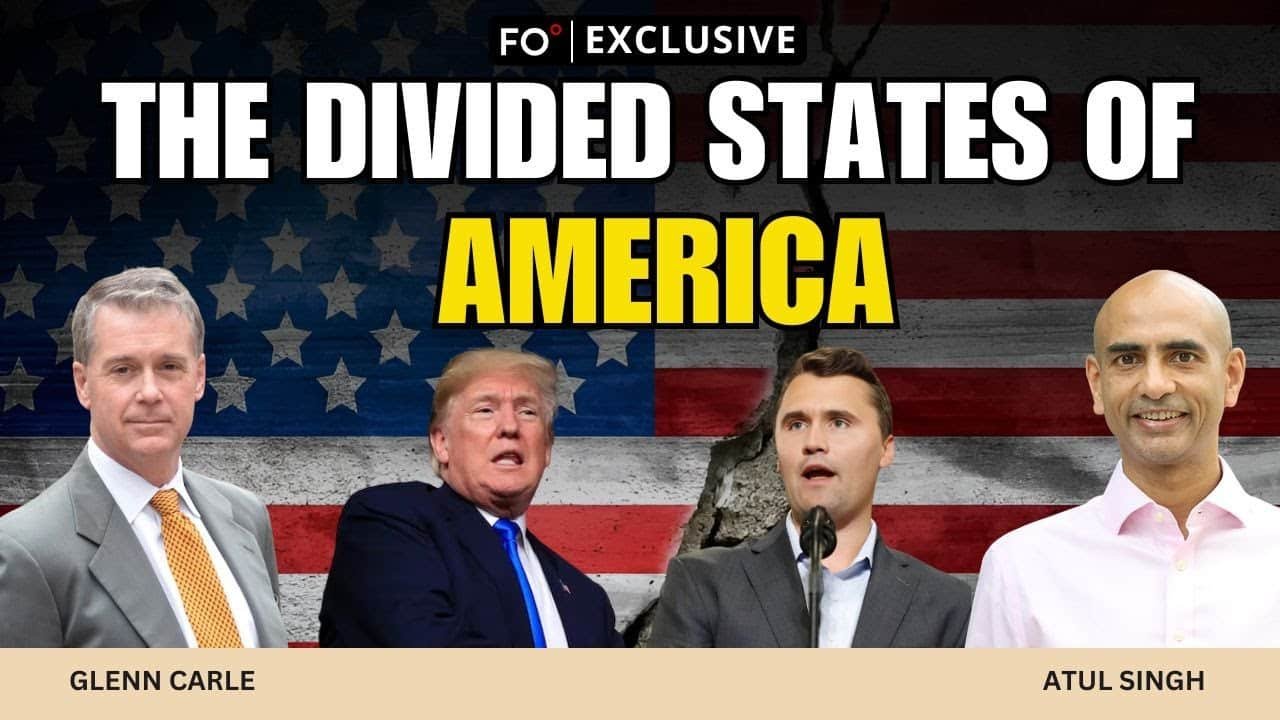
FO° Exclusive: The Divided, Not United, States of America

Glenn Carle”
post_date=”October 03, 2025 06:21″
pUrl=”https://www.fairobserver.com/world-news/fo-exclusive-a-round-up-of-what-mattered-most-in-september-2025/” pid=”158413″
post-content=”
Editor-in-Chief Atul Singh and retired CIA Officer Glenn Carle go through key developments in September. They begin by looking at US President Donald Trump’s appearance at the UN. In his speech, Trump boasted of ending seven wars, quipped about the escalator stopping abruptly and a teleprompter that was not functioning. He dismissed climate change as “a con job” and also criticized the UN as ineffective, claiming it neither helped him nor reached its potential. Atul points out the irony of Trump downplaying climate change precisely when the Arctic shipping route is gaining momentum.
The geopolitical rise of the Arctic route
This segues into a discussion on shipping routes and global trade. The speakers outline the objective facts: Attacks by Yemen’s Houthi militant group have made the Red Sea corridor through the Suez Canal and Bab el-Mandeb Strait increasingly dangerous. Many ships are now rerouting around the Cape of Good Hope and Cape Agulhas, the southern tips of Africa, which significantly increases costs and travel times.
Against this backdrop, the Northern Sea Route (NSR) along Russia’s Arctic coast is gaining importance. In 2016, only 19 ships made the journey via the NSR. By 2024, that number had risen to 92. This growth is spectacular.
Much of this traffic involves Russian commodity exports, especially natural gas, but container shipping is beginning to take off. A voyage from Ningbo, China, to Felixstowe, United Kingdom, via the NSR takes 18 days — less than half the time required to sail around Africa. Once the dream of British explorers, this Polar Silk Road is now a very real Chinese ambition.
Xi’s parade and global optics
The conversation shifts to China, where on September 3, Chinese President Xi Jinping presided over an 80th anniversary Victory Day Parade commemorating the end of the Second Sino-Japanese War. China views this triumph as the true conclusion of World War II. Xi hosted two prominent allies: Russian President Vladimir Putin and North Korean leader Kim Jong Un. The parade was “very impressive” — much more so than Trump’s military parade this June.
In the lead-up, Xi convened a summit of the Shanghai Cooperation Organisation (SCO). Atul highlights the optics of Indian Prime Minister Narendra Modi clasping Putin’s hand and walking toward Xi, remarking jokingly, “Talk about love — one hopes it’s brotherly.” The imagery of Xi, Putin and Modi together generated international headlines, reflecting the shifting balance of power in Eurasia.
US domestic policy: autism and immigration
Back home, the Trump administration stirred controversy when Health Secretary Robert Kennedy Jr. joined Trump in linking Tylenol and vaccines to autism. Trump announced a sweeping initiative to study the causes of brain disorders. Atul muses that his own “brain fog” and lapses in intelligence could now potentially be blamed on Tylenol.
Immigration policy has also undergone dramatic change. The administration imposed a $100,000 fee per H-1B visa application. Note that this fee does not guarantee visa approval. With the United States Citizenship and Immigration Services granting 85,000 such visas yearly, this Trump administration measure effectively ends the H1-B program, particularly hurting Indians who have availed of the lion’s share of this type of visa. Importantly. FOI had predicted tighter immigration controls as early as April 2024.
Europe, gold and tech
Briefly touching on European events, Atul cites Russian drones entering Polish and Romanian airspace, Russian MiG-31 fighter jets buzzing Estonia for 12 minutes before interception by NATO’s Italian F-35 aircraft and temporary closures of airports in Oslo, Norway, and Copenhagen, Denmark due to drone sightings. The EU and NATO are facing many defense and strategic challenges.
The uncertain geopolitical situation has caused gold prices to hit a historic high of $3,500 per troy ounce. In the corporate world, Google survived the greatest antitrust case since tech giant Microsoft’s battles in the 2000s. Also, Nvidia poured resources into OpenAI, signaling the deepening links between top tech companies..
Three core issues for September
Atul and Glenn segue into this episode’s main subjects by identifying three overarching issues that defined September 2025:
- The Divided, Not United, States of America
- Dollar Will Continue to Lose Value
- Economic Pain and Political Turmoil Around the World
[Lee Thompson-Kolar edited this piece.]
The views expressed in this article/video are the author’s own and do not necessarily reflect Fair Observer’s editorial policy.
”
post-content-short=”
Editor-in-Chief Atul Singh and retired CIA Officer Glenn Carle go through key developments in September. They begin by looking at US President Donald Trump’s appearance at the UN. In his speech, Trump boasted of ending seven wars, quipped about the escalator stopping abruptly and a teleprompter…”
post_summery=”In this September 2025 episode of FO° Exclusive, Atul Singh and Glenn Carle analyze US President Donald Trump’s UN address, where he dismissed climate change and criticized the UN. In an earlier speech in Washington, DC, Trump promised to investigate a proposed link between Tylenol and autism. Atul and Glenn look at other issues, such as the importance of Arctic shipping and the significance of summits in China.”
post-date=”Oct 03, 2025″
post-title=”FO° Exclusive: A Round-up of What Mattered Most in September 2025″ slug-data=”fo-exclusive-a-round-up-of-what-mattered-most-in-september-2025″>

FO° Exclusive: A Round-up of What Mattered Most in September 2025

Yves Zieba”
post_date=”October 02, 2025 04:50″
pUrl=”https://www.fairobserver.com/business/technology/fo-talks-is-ai-now-more-reliable-and-trustworthy-than-todays-journalists/” pid=”158389″
post-content=”
Peter Isackson, Fair Observer’s Chief Strategy Officer, speaks with Yves Zieba, CEO of Syntezia Sàrl. They discuss how artificial intelligence is reshaping journalism, media ethics and the very business models that underpin the industry. Isackson brings his own curiosity to the discussion, noting he is currently writing about AI and media. Zieba responds with a wide-ranging assessment of opportunities, risks and ethical imperatives.
AI in media
Zieba begins by stressing that AI is not a marginal development but a disruptive transformation in media. He argues that ignoring it is perilous: Companies that choose not to adopt AI risk rapid collapse in audience reach, advertising revenue and subscriptions. By contrast, those that embrace AI have a chance to reimagine their models.
Hyper-personalization stands out as one of the most promising innovations. Zieba points to Netflix as an example of how tailoring content to individual preferences can revolutionize an entire industry. Applied to journalism, AI-driven personalization could help news organizations engage audiences more deeply, cut through the clutter of “infobesity” and foster stronger ties between readers and their preferred journalists.
Journalists using AI
AI, Zieba explains, can take over repetitive “robot tasks” such as data formatting or drafting routine reports. This automation frees journalists to focus on investigations, analysis and high-value reporting. With AI accelerating production, a single journalist might publish 200 articles per month compared to 20 in the past.
Isackson raises concerns that tailoring content may still resemble a one-way monologue rather than a dialogue. Zieba counters that AI enables new forms of dialogue by creating intermediary roles in public relations and public affairs. Moreover, smartphones and citizen journalism provide “eyes and ears everywhere,” extending journalists’ capacity while reinforcing the importance of professional standards.
Can AI be transparent?
One of the major risks Zieba highlights is “hallucination” — AI generating plausible but false information. He calls for the rise of “hallucination checkers,” akin to fact-checkers, as editorial teams now carry the added burden of ensuring accuracy in AI-assisted work.
Transparency, Zieba insists, is essential. Just as journalists disclose their sources, they must disclose the AI tools used in producing content. Trust, he argues, ultimately rests with the person who signs an article and the institution that guarantees editorial oversight. Smartphones, crowdsourcing and citizen reporting may broaden information flows, but Zieba still places greater trust in professionals who can uphold standards.
Isackson adds a cultural dimension, suggesting hallucination is not unique to machines — human culture itself thrives on interpretation and fabrication. For him, the deeper issue is whether AI can contribute constructively to social dialogue rather than merely providing streams of information.
AI is changing media
Zieba emphasizes that AI is changing both the volume and the nature of journalism. Some reporters embrace AI for its creative advantages, while others fear job losses. Local sports writers or niche reporters are particularly vulnerable. The tension, he says, is between risks and opportunities: Ignoring AI is dangerous, but uncritical adoption also brings hazards.
For Zieba, the balance lies in recognizing AI as a tool, not a value proposition. It accelerates reporting and analysis, but humans must continue to provide judgment, insight and ethics. He believes that the media has a broader social role as a public good, contributing to civic education, citizen journalism and collective trust.
Journalists forced to use AI?
Management and regulation often lag behind the reality of newsroom practices. Zieba notes that many editors officially sanction only a limited set of AI tools, even while reporters secretly use more powerful ones. This creates tension: executives and regulators are “three steps behind,” unsure how to handle ownership, responsibility or ethical standards.
The result is a creeping sense that journalists may be compelled to rely on AI tools — both because competitors are doing so and because management will eventually demand it. For Zieba, the real danger is not using AI at all, or waiting too long, which he calls potentially “lethal” for any media organization.
The Chief AI Officer in media
This organizational challenge has given rise to a new position: the Chief AI Officer (CAIO). Zieba describes the CAIO as a board-level role, reflecting AI’s disruptive power that cuts across finance, legal, human resources and editorial functions. Unlike a Chief Technology Officer, who may see AI as just another tool, the CAIO must take a strategic view of AI’s potential to reshape the entire company.
This is not simply a technical job. A CAIO must provide leadership, coordination and vision, ensuring that AI strategy aligns with broader organizational goals. Without such oversight, Zieba argues, companies will stumble in the face of rapid technological change.
Navigating flux
Asked about the future, Zieba is candid: “There are more unknowns than knowns.” He cites the rapid obsolescence of once-hyped practices like prompt engineering as proof that AI evolves at breathtaking speed. Rather than pretending to predict, he favors a pragmatic framework he calls “flux,” designed to help organizations live with uncertainty.
The discussion ends on a note of shared appreciation. Isackson and Zieba agree that the debate over AI in journalism is far from finished. What remains clear is that the stakes — trust, ethics and the survival of media organizations — could not be higher.
[Lee Thompson-Kolar edited this piece.]
The views expressed in this article/video are the author’s own and do not necessarily reflect Fair Observer’s editorial policy.
”
post-content-short=”
Peter Isackson, Fair Observer’s Chief Strategy Officer, speaks with Yves Zieba, CEO of Syntezia Sàrl. They discuss how artificial intelligence is reshaping journalism, media ethics and the very business models that underpin the industry. Isackson brings his own curiosity to the discussion,…”
post_summery=”In this episode of FO° Talks, Peter Isackson and Yves Zieba explore how AI is transforming journalism, from newsroom automation to ethical concerns about hallucinations. Ignoring AI is fatal for media companies, while embracing it requires stronger editorial safeguards. Journalism’s survival depends on balancing AI’s risks and opportunities while maintaining trust and dialogue.”
post-date=”Oct 02, 2025″
post-title=”FO° Talks: Is AI Now More Reliable and Trustworthy Than Today’s Journalists?” slug-data=”fo-talks-is-ai-now-more-reliable-and-trustworthy-than-todays-journalists”>
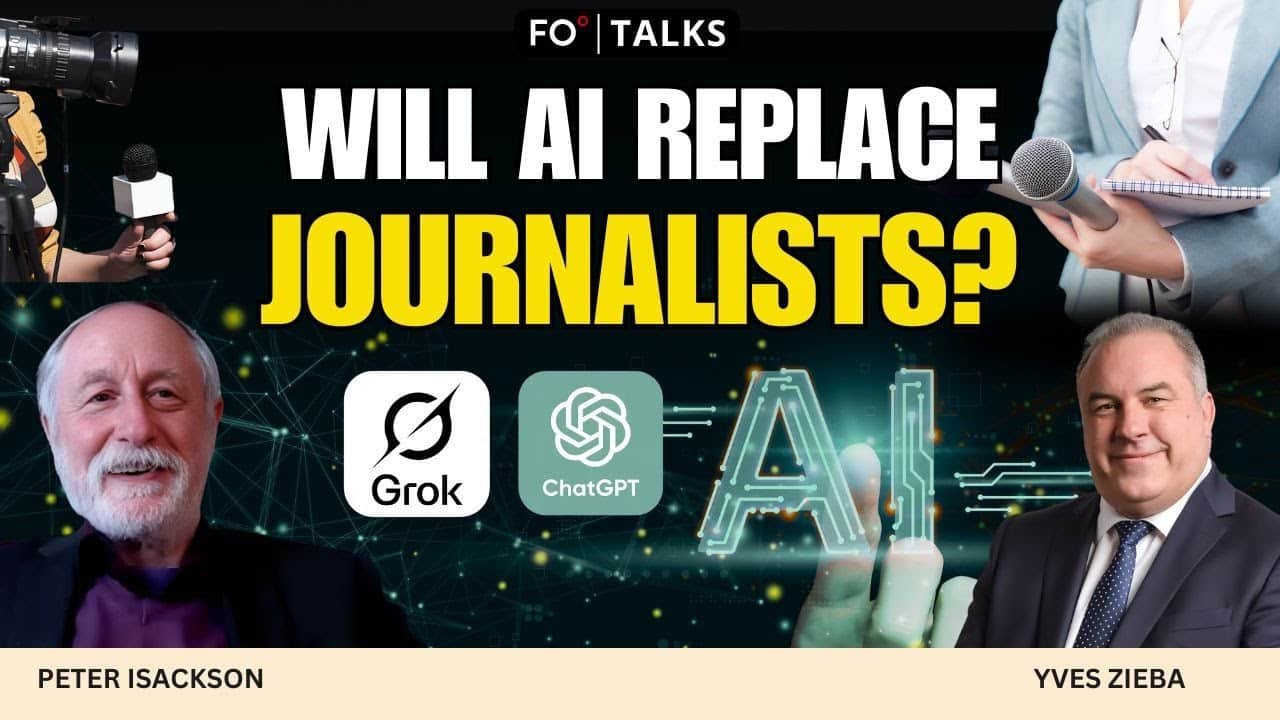
FO° Talks: Is AI Now More Reliable and Trustworthy Than Today’s Journalists?
